
Бесплатный фрагмент - Medical Astrology Guide
Death and Disease in Vedic Astrology
Preface
The book you have opened contains the results of a study I conducted during the first half of 2020 on identifying the type of death, its timing, and determining the diseases that threaten a person or remain with them for many years.
During my study, I analyzed the natal charts of deceased individuals (80% of the total sample) and those who are still alive (20% of the total sample). I am deeply grateful to everyone who shared the birth charts of their loved ones and themselves with me. Without their trust and generosity, this book, along with the invaluable data I have collected, would not be possible.
As I write this introduction in 2020, the world is grappling with the COVID-19 pandemic, a highly contagious virus causing severe viral pneumonia.
Doctors on the front lines in Spain and Italy estimate a 20—25% mortality rate from the virus, while Chinese authorities report it at 4.5%. European authorities have cited a mortality rate of around 1%. Only time will tell who is right.
While people are hunkering down at home in fear, global economies are experiencing unprecedented turmoil, with billions of people stuck in quarantine. In this chaotic environment, understanding how our Vimshottari periods will play out is more critical than ever: will they bring comfort at home or pose dangers within hospital walls?
I have recently noticed a recurring pattern in the birth charts of those seeking my guidance: the activity of the planets Ketu and Mercury, or the rulers of the 6th and 12th houses. Those more susceptible to lung issues can gain valuable insights into their natal charts and the potential danger periods. I hope this knowledge helps them minimize contacts and stay extra cautious.
I am thrilled that this study will empower astrologers to detect chronic illnesses, identify their onset, and clarify periods that might bring about death.
In this book, I will challenge many classical formulas widely accepted as favorable, while experienced predictive astrologers understand the extent of misunderstanding among others who do not even attempt to forecast using astrology.
I believe astrology was designed for prediction, not for delving into psychological issues or energy diagnostics.
Eastern culture has always prioritized practicality, focusing on survival and social integration. Jyotish emerged out of a need for future predictions, not to analyze personality traits. That is why we have so many predictive techniques at our disposal.
Western astrologers, when transitioning to Vedic astrology, often do not give up their habit of interpreting natal charts for psychological purposes. I contend that prediction is the true treasure of Jyotish, while psychology remains a separate field dedicated to understanding thoughts and emotions. Many disagree with me due to their lack of experience in predictive work with client feedback. As a result, they spread ineffective techniques and ideas that have nothing to do with true practice.
In this book, I will use Navamsa sparingly, doing so intentionally to highlight the importance of the division chart D-6, often overlooked in traditional analyses. Navamsa is a powerful predictive tool, where planetary positions, Yogas, nakshatras, and other key points are interpreted alongside the Rasi chart. For similar reasons, I will not focus on Chara Dasha analysis; instead, I will concentrate on Vimshottari Dasha. A deeper knowledge of this Dasha system will help you be confident in 90% of your judgments, with only a few birth charts requiring verification by other methods.
I urge you to approach the topics of death and disease with philosophical detachment and avoid being overly dramatic. Death and illness are natural parts of life, just like achieving success or starting a family. I have never understood astrologers who make up nonsense about how death and disease are off-limits for study. They say all sorts of things, such as that the astrologer takes on the same fate they predict, or that someone will be born blind in their next life…
I am convinced that only a few can predict with such precision that they can distinguish between sickness and imprisonment or death and job changes. Others justify their lack of skill and unwillingness to learn by spreading these myths.
Remember that something Great controls who comes to you for consultation, at what stage of their life, what they should know, and what they should not. If the Higher Powers do not allow a person to discover dangerous knowledge, the birth chart will reflect nothing but confusion instead of meaningful insights. This concludes the prognosis within the framework of this astrological chart.
Health in Natal Chart
Looking at the birth chart through the lens of health involves identifying its weak points. This approach differs from the usual methods of chart interpretation. It is important to be able to store many small pieces of information in short-term memory in order to make good judgments.
Keep in mind that no planet is simply good or bad. It affects many areas of life, depending on how it is placed in each divisional chart.
So, what are these weak points? In astrology, we operate under the assumption of innocence until proven guilty.
A planet that is not known to be associated with malefic influences or harmful houses is considered neutral by default. If it is not negatively influenced, something we will explore throughout this book, it is regarded as innocent and is likely to support normal health during its period and sub-period of Vimshottari Dasha.
It is also crucial to differentiate between living and non-living indicators of the houses.
For example, the living indicators of the first house reflect health, personal freedom, and overall well-being.
The non-living indicators include social status, talents, personality strength, and similar traits.
The Sun as a malefic, being in the 1st house, will affect the living indicators of the house and enhance the non-living ones. This is the way all malefic planets function, such as Saturn, Mars, Rahu, Ketu, and the previously mentioned Sun.
The negative effects can be minimal if the planet in the 1st house has no significant afflictions from aspects and is not in debilitation. It is advantageous if the planet does not have extreme placements, neither exalted nor severely afflicted by malefics.
For instance, if an exalted Jupiter is located in the 1st house, which happens for the Cancer Ascendant, its period may pose a threat of significant illnesses because it becomes the strong ruler of the 6th house, making it a functional malefic for the Cancer Ascendant.
The fact that people with poor astrological charts live into middle age and beyond indicates only one thing: that very Vimshottari Dasha period has not yet begun.
Overview of Health Condition
It is very important to be able to correctly interpret the birth chart from the perspective of Medical astrology and not to confuse the effects related to career achievements with those concerning health. The same period can bring a dizzying rise in career as well as physical suffering simultaneously.
To assess a person’s health condition and their potential to live free of diseases, it is necessary to examine the natal chart from a special point of view.
Here are the key points on which good health in the astrological chart is based:
— 1st house free from malefic influences.
— A well-placed ruler of the 1st house (not conjunct malefics, not combust, not hemmed in between two malefics, etc.).
— The direct motion of the 1st house ruler and the planets aspecting the 1st house and the Lagnesha.
— The Kendras are occupied by functionally benefic planets without major afflictions.
— Dusthana lords of moderate strength, free from afflictions and not showing signs of exceptional power.
— Malefics placed in the 3rd, 10th, and 11th houses.
— Dusthanas free from planetary occupation.
— Absence of debilitated planets that are connected to the 1st, 6th, 8th, or 12th houses.
It is unlikely that one will find the natal chart that fully meets all these criteria. I will prove this to you by using a reverse approach.
Remember that all people are mortal. This is an unchangeable law of existence in the material world. One of the nine planets must take on the responsibility of guiding a person from death to a new life. Therefore, there will always be a planet or conjunction in the astrological chart that appears threatening.
By keeping in mind that such a planet must exist, you can quickly discern which one it is upon first glance at the natal chart. You just need to look at the Vimshottari Dasha periods to determine the duration of a person’s life and identify when a dangerous period may begin. The rest is purely technical.
I have described an ideal situation where a person never gets sick and dies rapidly due to the influence of a single affected planet. However, it is essential to recognize that a complex of negative influences often arises from other planets and critical points in the birth chart.
The affliction of planets and health arises from the influence of the rulers of the Dusthanas, natural malefics, Gnati Karaka, Maandi, Gulika, and so on.
Even if the natal chart contains no combust or retrograde planets, no planets in fall, and the ruler of the 1st house is excellently placed, there are still factors that are impossible to avoid at birth:
— the Sun, Mars, Saturn, Rahu, and Ketu are always present in the sky;
— there will inevitably be planets that take on the rulership of the 6th, 8th, and 12th houses.
Of the nine planets, only four are considered benefic, while five are malefic. Among these four benefics, two or three may serve as rulers of the 6th, 8th, and 12th houses, rendering them malefic in the context of Medical astrology.
In other words, despite having an overall favorable chart, only one or two planets remain ideal for health, while the rest are afflicted to some degree.
No single planet may be entirely auspicious in many cases. This is evident when examining numerous real-life cases in this book. So, why do these individuals often live into adulthood?
Remember, there is usually one planet or combination that poses a greater threat than all the others. The Dasha of that planet becomes critical, and it often does not begin immediately.
Planets Assessment
When predicting an individual’s health, it is vital to consider not only the natural characteristics of each planet in their natal chart, but also the specific functions the planet performs in that chart and which houses it rules.
I have seen numerous birth charts where disastrous events occurred during the Antardasha of Jupiter or Venus, even though they are considered the greatest benefics in astrology. This underscores the importance of examining the specific functions of each planet within an individual’s chart.
A planet can become malefic for someone’s health if it is:
— positioned in the Dusthana houses (the 6th, 8th, and 12th);
— a malefic planet (like Saturn, Mars, Rahu, Ketu, or the Sun) occupying or aspecting the 1st house or its ruler;
— retrograde;
— in its fall sign;
— the ruler of the Dusthana houses (the 6th, 8th, or 12th houses);
— combusted;
— involved in a planetary war with a Dusthana lord or a malefic planet;
— in conjunction with or aspected by the ruler of the Dusthanas;
— occupies the same house as one or more malefics.
These are the key signs that indicate a planet could negatively impact health during its Mahadasha or Antardasha in the Vimshottari system.
Let us consider an example.
Case Study 1: Underweight and Low Immunity
This woman suffers from low body weight and weak immunity. She also experiences eating disorders and chronic neurasthenia.
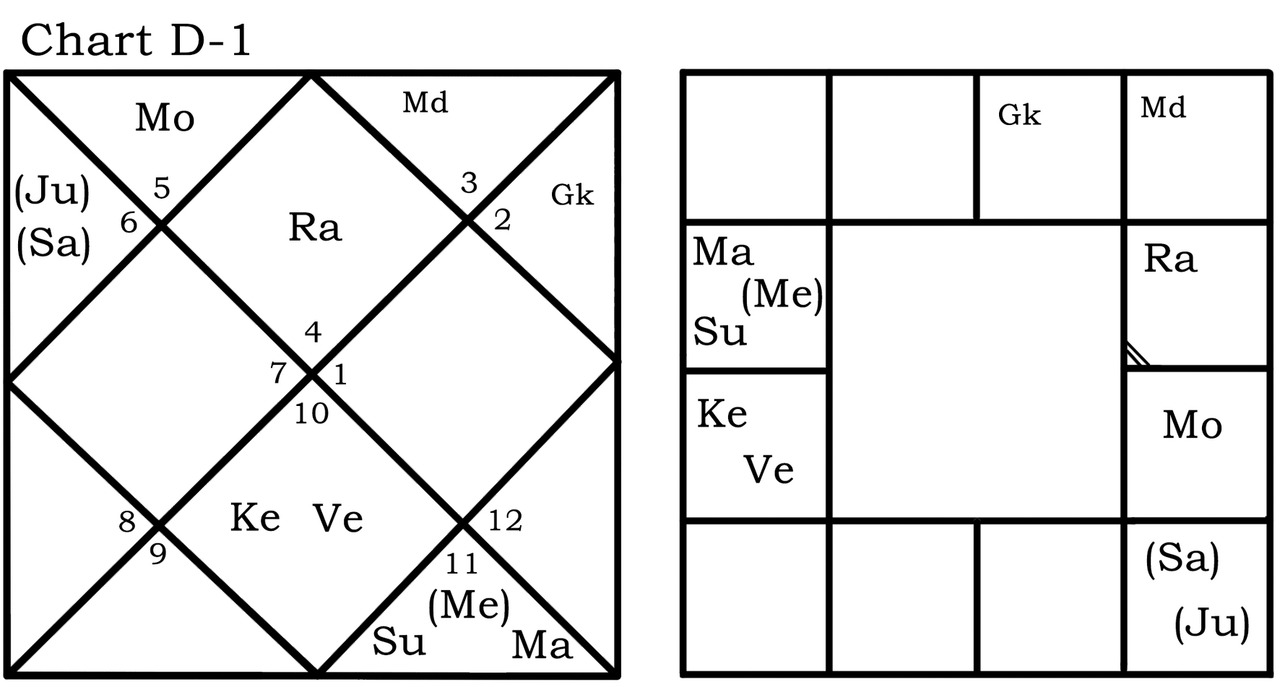

Among all the planets in this natal chart, the most harmful to health will be:
— Saturn, the ruler of the 8th house, is retrograde and conjoined with Jupiter, the ruler of the 6th house. It is also aspected by Mars from the 8th house of crises.
— Jupiter, the retrograde ruler of the 6th house, is conjoined with Saturn and also receives an aspect from Mars positioned in the 8th house.
— Mercury, as the ruler of the 12th house placed in the 8th house, is also retrograde and conjoined with two malefics, Mars and the Sun.
When several malefics converge in one area, the planets with a gentle nature, that are considered benefits, are affected the most. It is similar to a thief feeling far more comfortable among gangsters than an honest person would. That is the situation Mercury finds itself in here.
When a malefic planet is isolated from the 1st house and its ruler, its negative effect may be less severe than if it aspects the 1st house and its ruler, or is placed in the Lagna.
In this chart, Mercury connects to the 1st house through its aspect on the Moon, suggesting that treatments for her current illnesses offer no relief. During Mercury’s Antardasha, the woman faced an aggravation of her eating disorders following her divorce.
This case lacks well-placed planets that would predispose an individual to good health. For strong health to prevail, it is important that some planets in the chart remain unaffected by malefic influences. One can rely on the Dasha of such well-placed planets, especially if they are found in the Kendras.
Looking ahead, we can expect that the Dashas of Jupiter and Saturn will pose particular challenges for her. Both Dashas occur after the age of 40 and are tied to the 8th house, which is associated with death, and both are afflicted by Mars. We should also examine the Chara Dasha to make an assumption about her life span.
The key to accurate prediction is to take a broad view of the natal chart and identify both supportive and harmful combinations within it. This is an extremely useful ability. By doing this, you will be able to notice subtle details and avoid being misled by them.
Jupiter: The Absolute Benefic?
Throughout this book, you will find many cases illustrating that Jupiter is not always a planet of benefits. For an astrologer aiming for high predictive accuracy, it is crucial to examine what the planet has become in this specific astrological chart: a malefic or a benefic.
Jupiter is often implicated in illnesses such as cancer, liver disease, thyroid disorders, and diabetes. Its period cannot be beneficial for everyone. In fact, in many cases, Jupiter is profoundly flawed.
For Jupiter to provide favorable health benefits, the following conditions must be met:
— it should not be Gnati Karaka;
— it should not rule the 6th, 8th, or 12th houses;
— it should not be retrograde, combust, or linked with a debilitated planet;
— it should not be aspected by malefics or by the lords of the Dusthanas.
These guidelines apply to both the main Rasi chart and the D-6 chart.
An affliction of Jupiter in the D-9 chart may relate to matters of marriage, or they may concern health, but its role in the D-6 will be decisive.
To illustrate this, I will present two astrological charts that demonstrate how the roles of natural malefics and benefics can be completely reversed.
Case Study 2: Diabetes
This is the natal chart of a woman affected by diabetes.
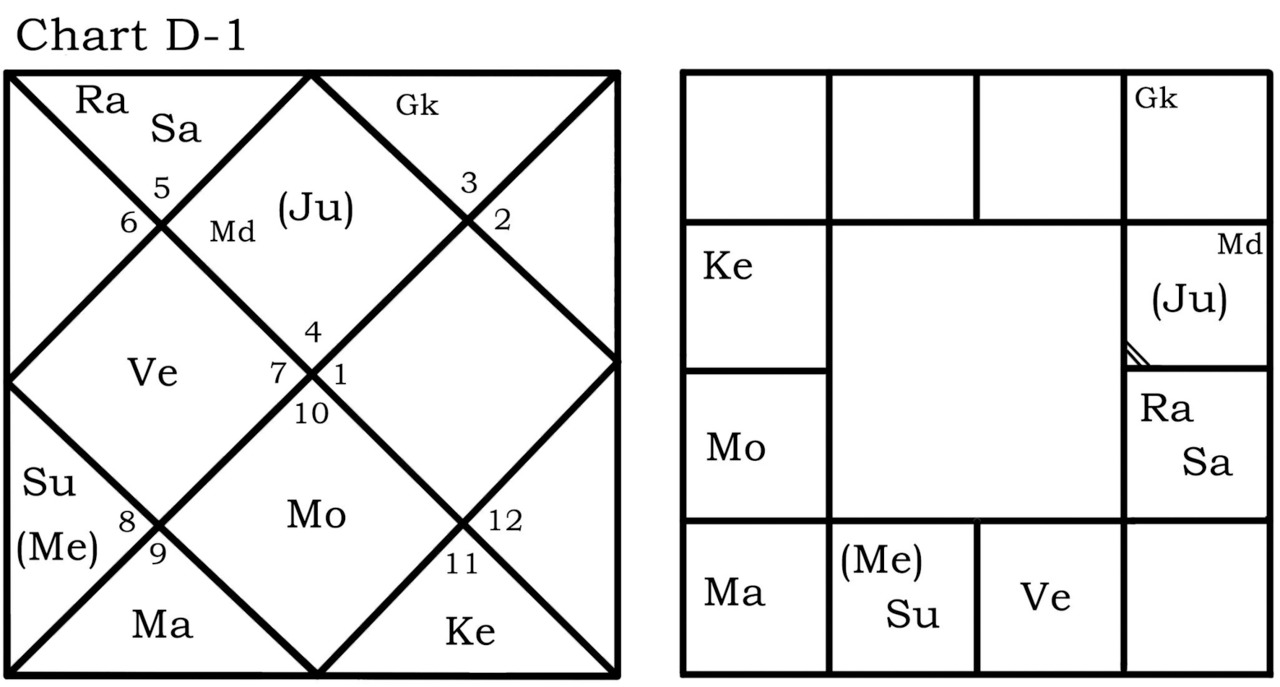

We see an exalted Jupiter located in the 1st house. It seems like nothing could be better.
However, this Jupiter is the lord of the 6th house of disease, which means it acts as a strong malefic in the Lagna.
Despite its exaltation, Jupiter’s functional malefic nature triggered diabetes at the beginning of its Dasha.
Now, here is the second example of a chart illustrating how the roles of benefics and malefics can be reversed.
Case Study 3: Breast Cancer
This chart belongs to a woman who has survived breast cancer twice.
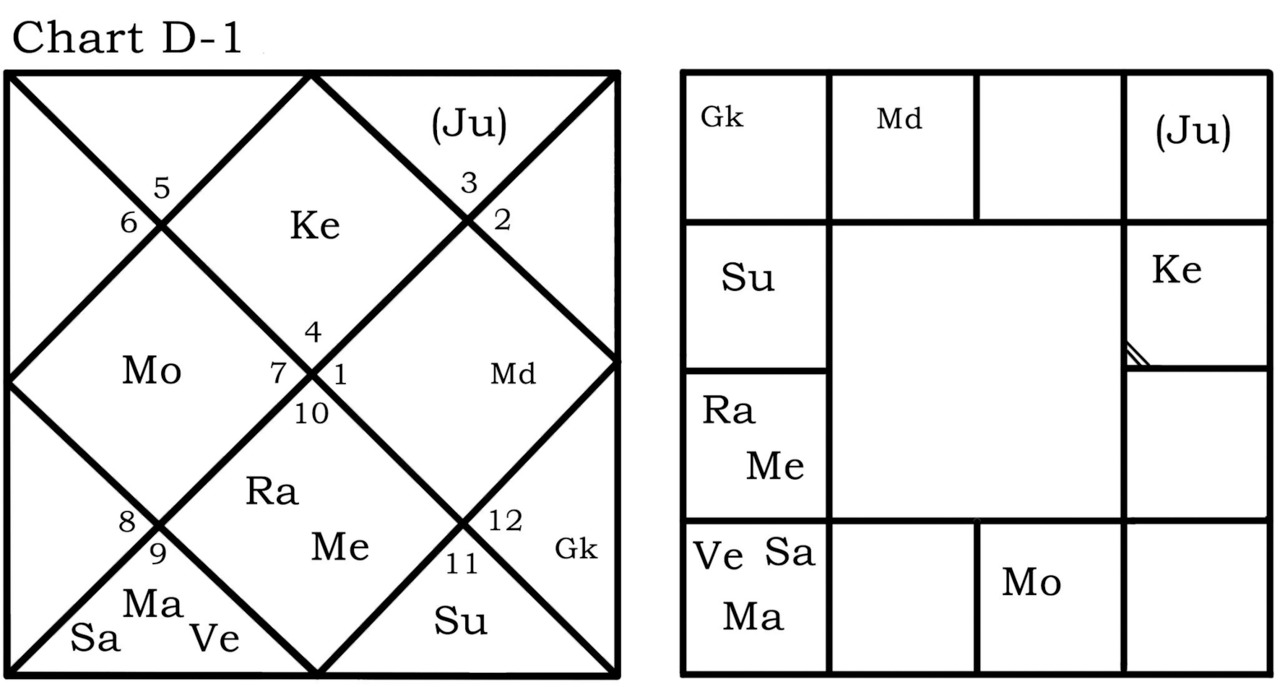

This type of cancer is often observed when the Moon is placed in Libra, particularly in conjunction with the fixed stars Unukalhai and Zubenelgenubi (also known as the Southern Claw), both of which are traditionally associated with oncological tendencies.
In this chart, there are indications that the illness may lead to complications — the ruler of the 8th house is placed in the 6th, and Jupiter, the ruler of the 6th house, aspects the ruler of the 1st house.
During the Saturn–Moon period, she fell ill for the first time.
Saturn forms classic combinations associated with severe and chronic illnesses: it rules the 8th house, is placed in the 6th house, and receives the aspect of retrograde Jupiter, the lord of the 6th house.
The Moon is placed in Vishakha Nakshatra, which is ruled by Jupiter. Jupiter is an indicator of illness for Ascendant Cancer natives. The Moon, ruling the 1st house of health, is afflicted by the aspect of retrograde Jupiter from the 12th house of healing and hospitals.
During the Saturn-Mars period, the woman experienced a remission of the disease, suggesting that it had receded.
In this context, Mars played the role of Raja Yoga Karaka, effectively overcoming the afflictions associated with the 6th house. If I had relied solely on Mars’ natural significations back then, I would not have been able to make an accurate prediction about the recovery.
However, during the Saturn–Rahu period, the illness returned.
Rahu, being a malefic, was conjoined with Mercury, the ruler of the 12th house. Afterwards, the woman went into remission again.
When the Saturn–Jupiter period begins, the illness is likely to return once again.
These cases highlight that although Jupiter is often regarded as the greatest benefic, especially by those who study extensively but lack hands-on experience in predictive astrology, its role can be complex and sometimes harmful, particularly when considering its afflictions and rulerships within a chart.
Gnati Karaka
A planet that takes on the function of Gnati Karaka (GK) is dangerous to human health. Gnati Karaka is the significator of the 6th house in the Jaimini system. It indicates troubles, debts, conflicts, and ailments.
When examining the Vimshottari Dasha period or sub-period of the planet identified as Gnati Karaka, one must exercise caution, as this can often signal harmful influences for the health of the native. This becomes especially pertinent if Gnati Karaka aspects the 1st house or its ruler, or if it is closely conjoined with them.
It is noteworthy that the strength of Gnati Karaka plays a crucial role in determining its impact. If Gnati Karaka is significantly strong or weak, it has the potential to cause greater harm. It is preferable for the Gnati Karaka in the astro chart to have moderate strength: being placed in a friendly sign and not significantly influenced by conjunctions with other planets.
An exalted Gnati Karaka, conversely, tends to indicate formidable resistance and significant obstacles, particularly in the house it occupies.
For example, if Gnati Karaka occupies the 1st house or is positioned near its lord, the individual may encounter challenges related to health and overall well-being.
Let us take a look at the natal chart of Prince Albert II, Prince of Monaco.
Case Study 4: Prince Albert II
On March 19, 2020, the whole world learned that the Prince had contracted COVID-19.
The Dasha of Saturn began in the birth chart of the monarch on February 29, 2020.
At the time of infection, he was experiencing the Saturn–Saturn period.
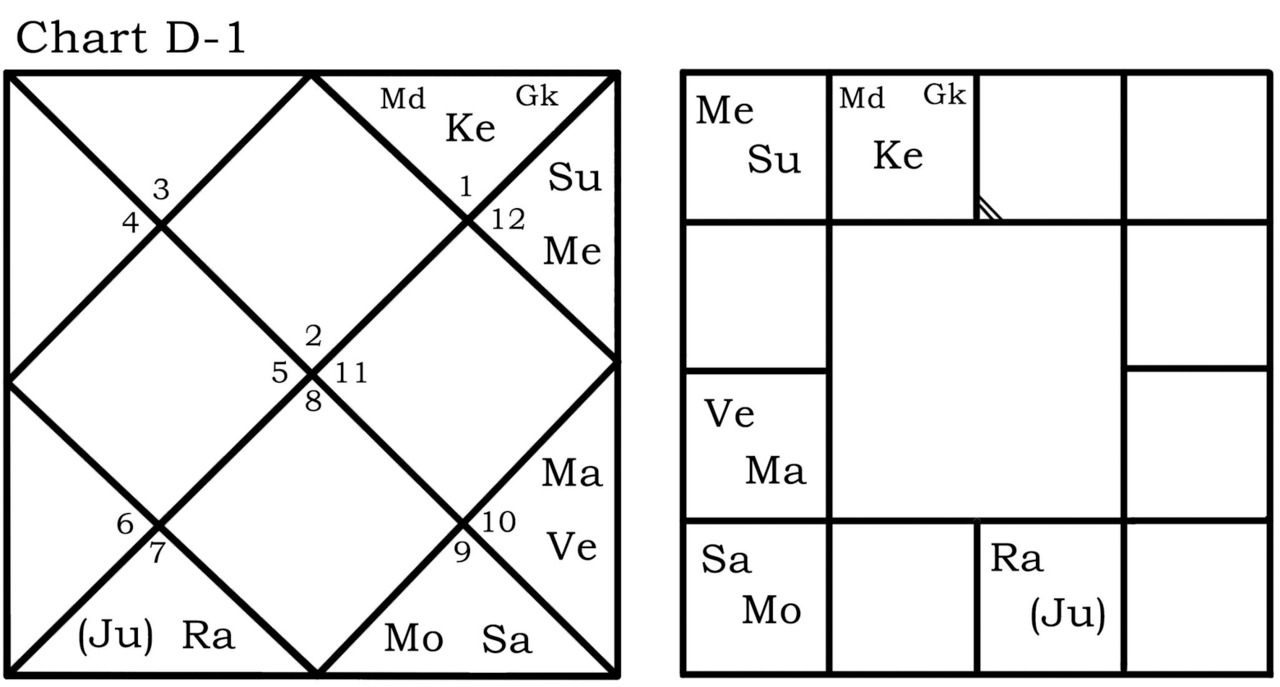

In this example, Saturn serves as Gnati Karaka. It is positioned in the 8th house, in conjunction with the Atma Karaka, the Moon.
The divisional chart D-9 is also not very favorable for Albert.
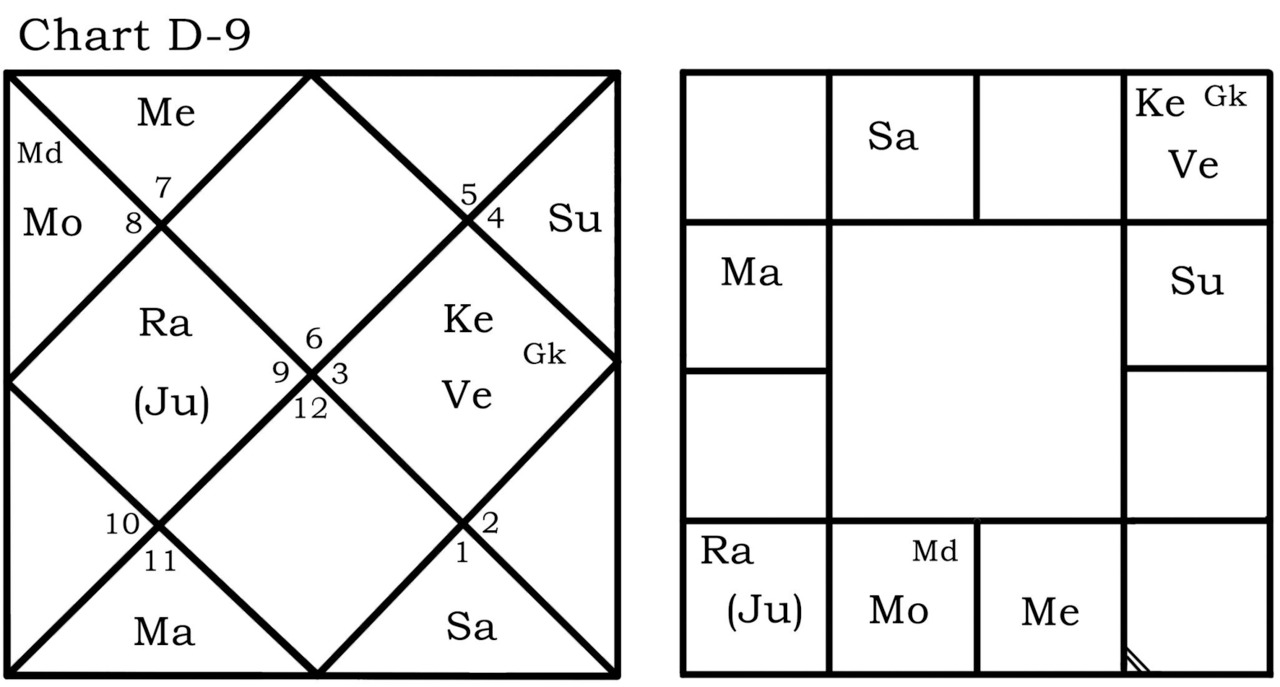
Saturn, which rules the 6th house of disease, is debilitated and located in the 8th house of death and the escalation of any issue, whether it be a conflict, a lawsuit, or an illness.
Without a doubt, the Saturn period is the most difficult one in this chart — the period, the one that stands out.
An illness occurring right at the beginning of the Saturn Dasha is a bad omen, pointing to the characteristics of the ruler of the period.
If you lack sufficient knowledge and experience, be sure to ask the client about what transpired during the Antardasha of that particular planet. This will help you understand the nature and influence of the planet in the natal chart at hand.
In Prince Albert II’s D-6 divisional chart, it is evident that the Saturn Dasha is particularly perilous.
Saturn rules the 12th house of treatments, and its condition indicates that medical interventions during this time cannot fully cure the individual.
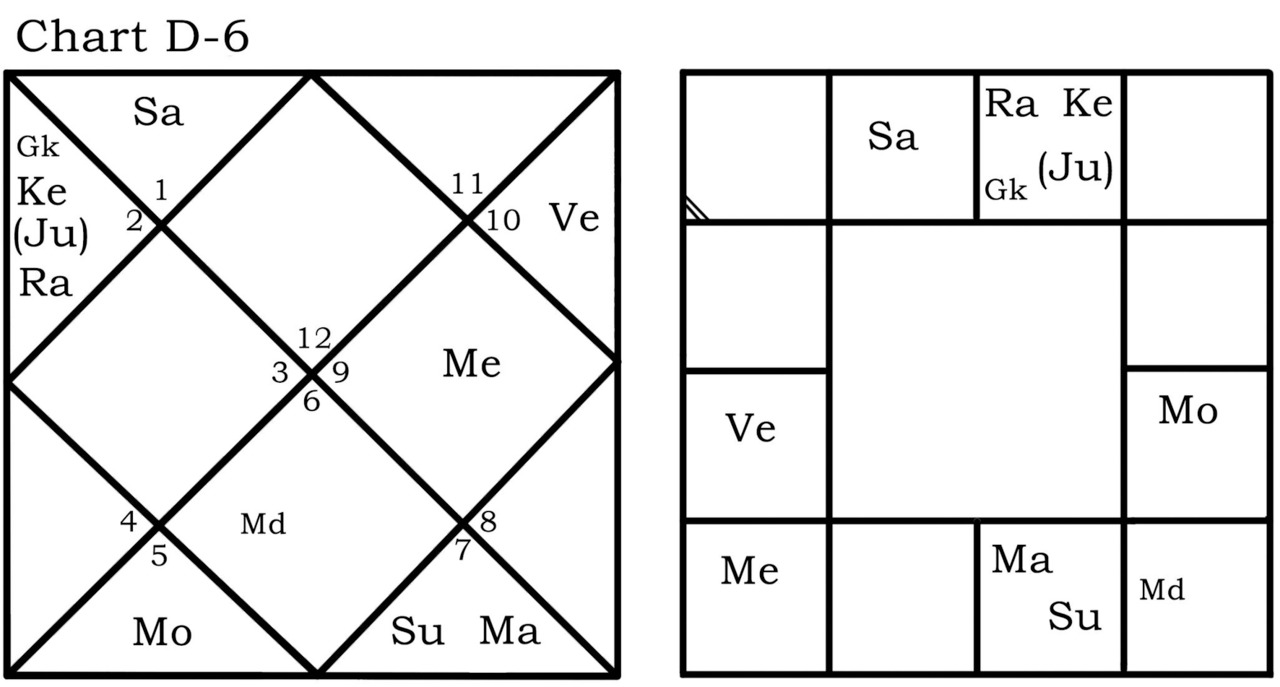
Saturn is aspected by Mars and the debilitated Sun from the 8th house of death. Moreover, the Sun is the ruler of the 6th house of diseases.
Case Study 5: Car Crash
Below, you can see the astrological chart of an individual who tragically died in a car accident.
This happened during the Venus-Saturn period.
In this example, Venus is the Gnati Karaka and is positioned in the 6th house.
Saturn, the ruler of the 6th house, is placed in the 8th house, which contributed to the fatal outcome.
The 8th house of this natal chart clearly indicates a violent death. Three of the most malefic planets are situated here, suggesting a lack of longevity.
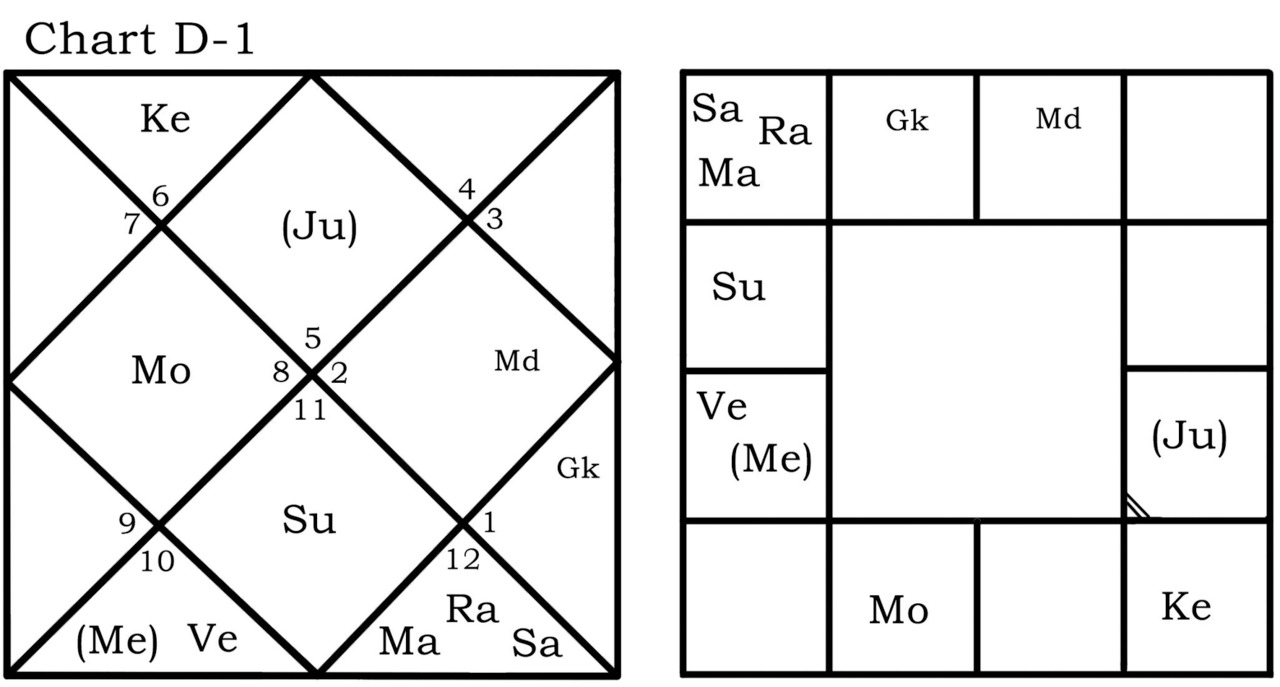

We can revisit this case later to analyze it further in order to determine the nature of the death.
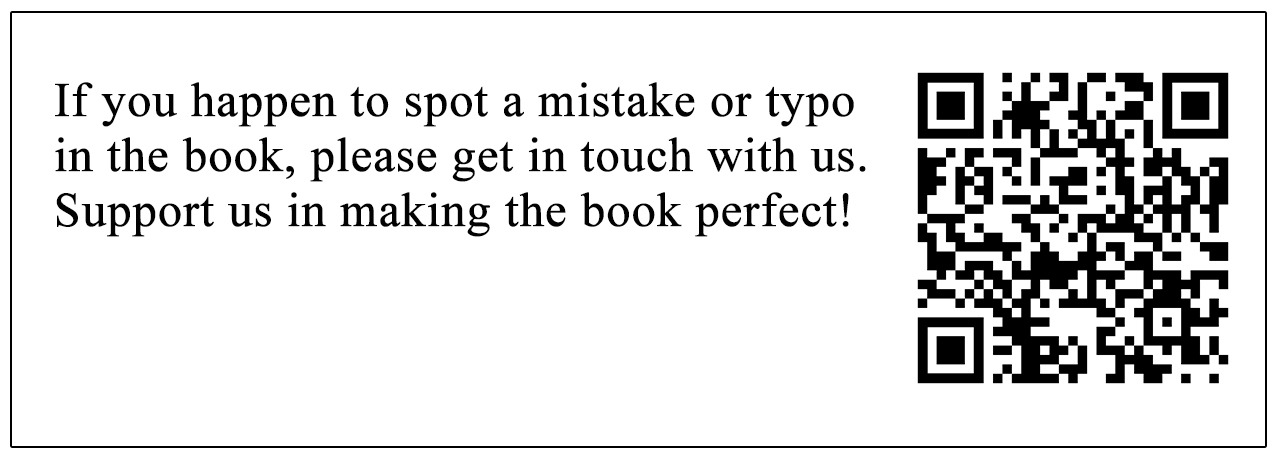
Maandi and Gulika
The shadow points Gulika and Maandi play a crucial role in evaluating planetary influences that may negatively affect the native’s health. These Upagrahas are highly malefic and destroy everything they come into contact with.
It is favorable when they occupy different houses, as this means they never influence the same area of life simultaneously, and therefore cause less harm.
When assessing a person’s destiny using the principles of Chara Dasha, we must continually shift the temporary Lagna to the sign of the zodiac whose period is currently ruling the individual.
When Maandi and Gulika are placed in the same house, they tend to consistently bring affliction as they transit from one house to another. Eventually, they are likely to occupy the 1st house of health or the 8th house of life expectancy, posing an additional threat to the native’s well-being.
Case Study 6: Ronald Reagan
Here is the natal chart of Ronald Reagan, the 40th President of the United States, who suffered from Alzheimer’s disease and ultimately died from pneumonia caused by an incurable illness.
He passed away during the Sagittarius–Virgo period according to Chara Dasha.
During the Sagittarius period, Maandi and Gulika were aspecting the 1st house of health, as all dual signs influence each other.
The sub-period of Virgo left no chance for recovery, as Maandi and Gulika were located in the 1st house.
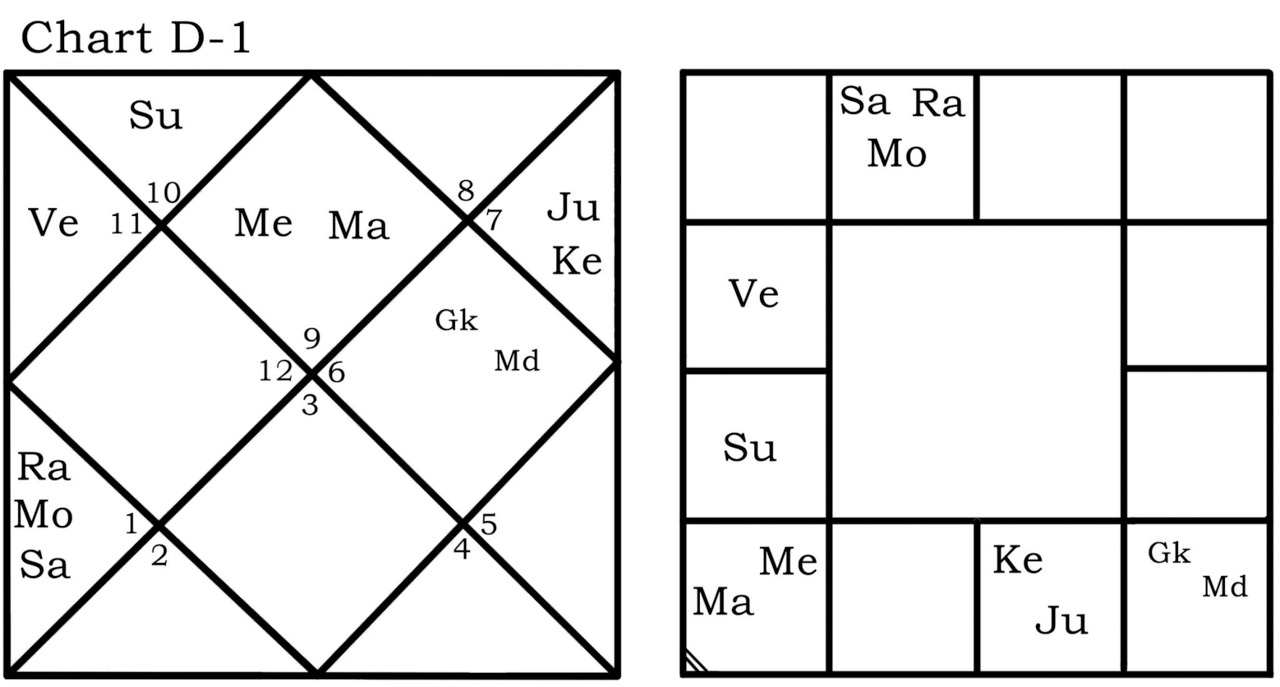

The situation worsens when Maandi and Gulika surround a specific planet, as this can seriously impact the person’s well-being, leading to mental suffering or even death.
The effect of this situation can be compared to Papa Kartari Yoga, where the Lagna is hemmed in between two malefic planets.
Always keep an eye on whether:
— Maandi and Gulika are in the same house or not;
— there are any planets nearby.
If Maandi and Gulika are in the same nakshatra as a planet, this will negatively affect the results the person experiences during that planet’s period.
The most troubling situation arises when the Ascendant or the ruler of the 1st house is surrounded by Maandi and Gulika. This often indicates a decline in the family line to which the individual belongs. This is also one of the signs that the person is unlikely to have successful offspring.
Typically, this positioning of the Ascendant and the Lagnesha suggests that a person’s life is overshadowed by some sort of spiritual or physical ailment.
Let us examine an example of such a situation.
Case Study 7: Addiction
The native, beyond marriageable age, has no children, lives in poverty, suffers from addictions, and has attempted suicide.
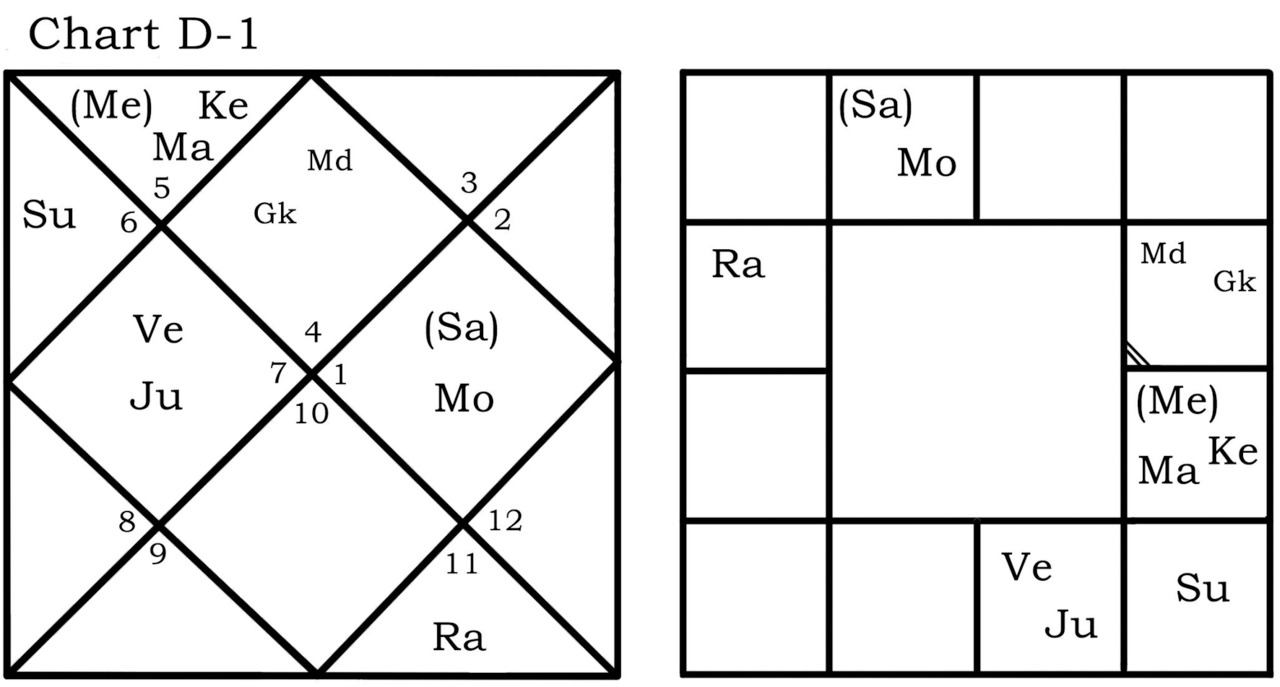

The Lagna in this natal chart is between Maandi and Gulika.
I often observe that individuals whose Lagnesha or Lagna are situated between these Upagrahas often cannot have children, or if they do, the child may not be a successful heir due to various illnesses or destructive personality traits.
Here is an example where Gulika plays a significant role concerning Mars and the marital life of the individual. The Upagraha is located in the same sign as the ruler of the 7th house.
Case Study 8: Marital Breakdown
In the following example, a man broke up with his wife without any significant reason, which ruined his family life.
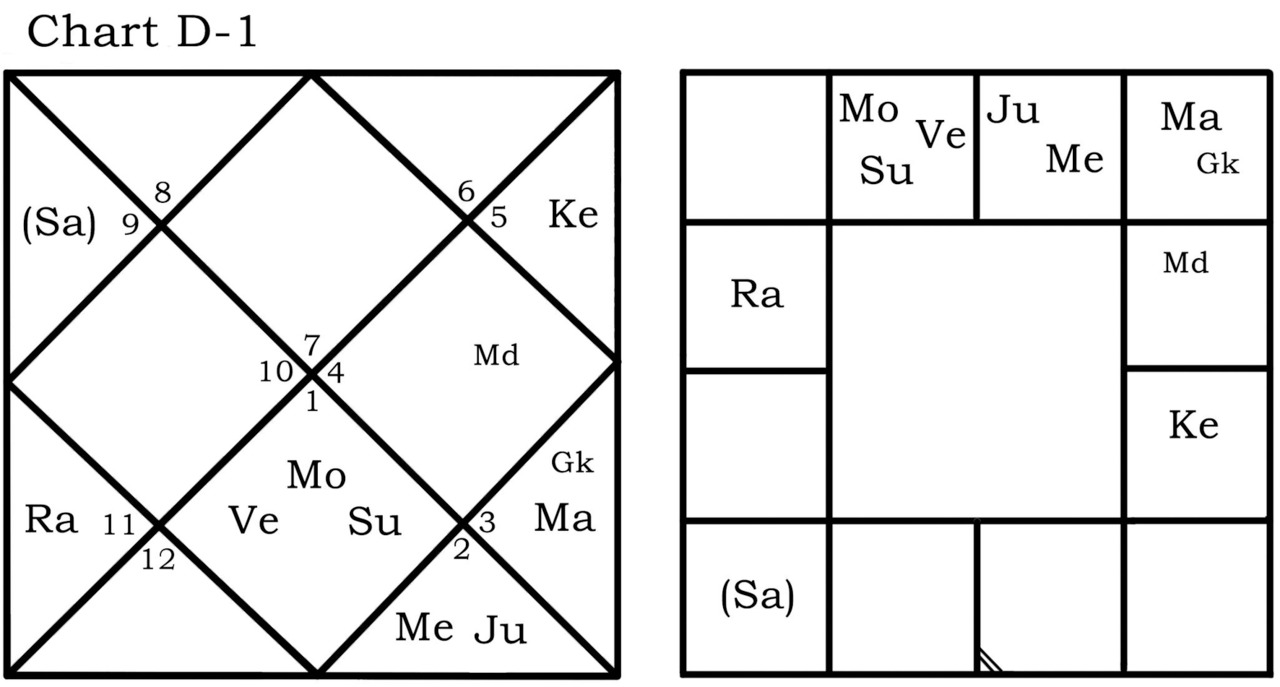

This happened during the Moon–Mars period.
If Mars had been the ruler of the 1st house or had aspected the 1st house, it could have had detrimental effects on his health.
Additionally, it is worth noting that Mars’s 8th aspect affects matters related to the 4th house. As a child, the chart owner experienced abandonment when his mother left him for a new marriage, leaving him to live with his father.
Case Study 9: Death in Childhood
In the following example, Maandi and Gulika afflict the child’s Lagna. He passed away shortly after reaching the age of three.
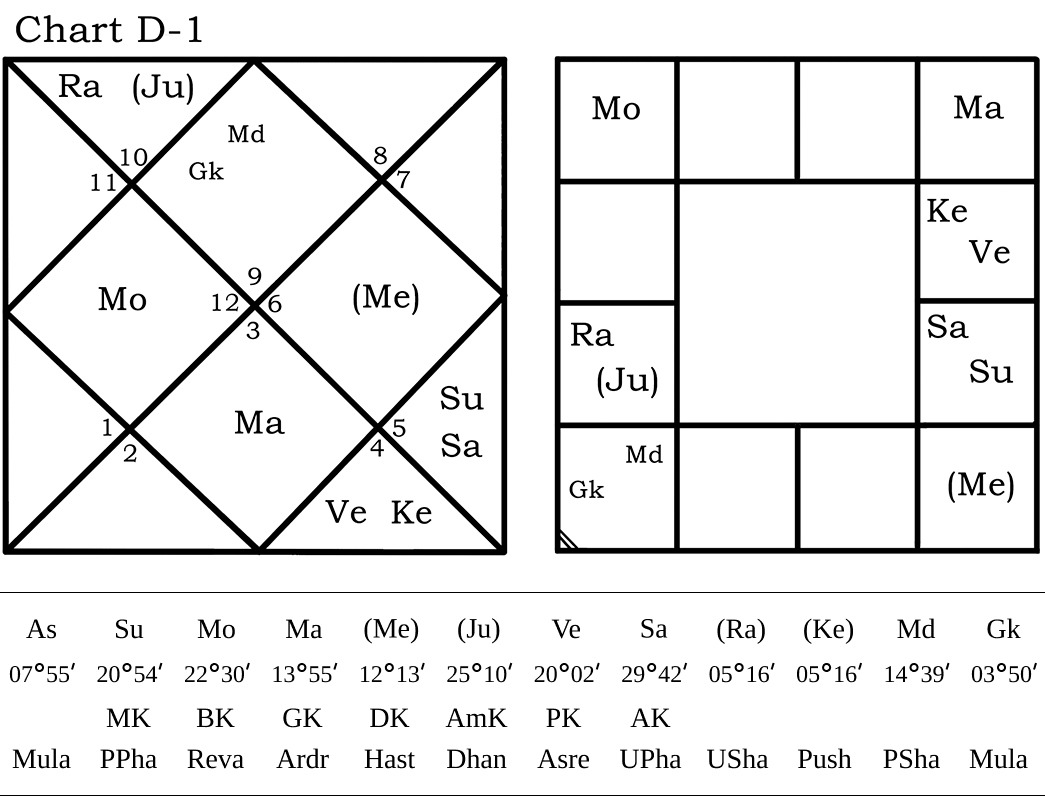
Any house cusp can be caught between the Upagrahas Maandi and Gulika. It is crucial to check if these points fall at the beginning of the house so you can determine if they will cause harm.
To find out the degree at which the house begins, you need to know the degree of the Lagna. In Jyotish, an equal house system is used, meaning each house starts at the degree of the Ascendant.
In this case the Lagna degree is hemmed in between Maandi and Gulika, and the lord of the 1st house is:
— debilitated;
— under the aspect of Mars, the ruler of the 12th house;
— under the aspect of Venus, the ruler of the 6th house associated with diseases and accidents.
Case Study 2: Diabetes
Here is the case of the woman discussed in the chapter about Jupiter, who was diagnosed with diabetes.
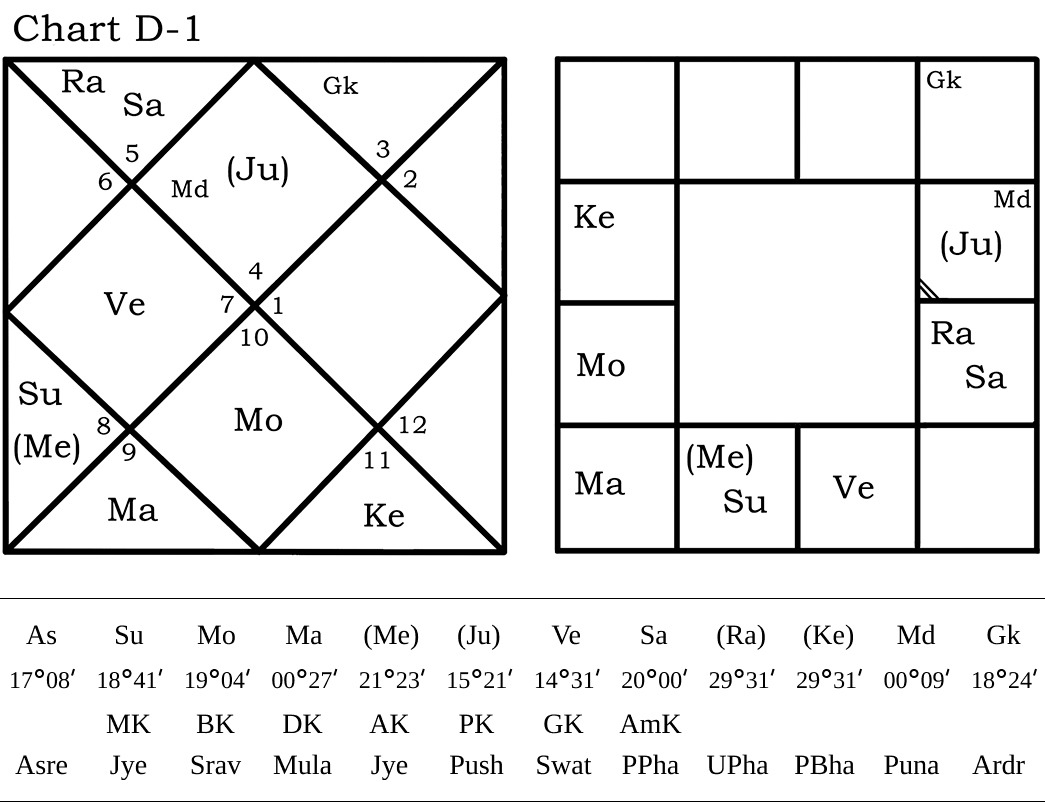
Maandi and Gulika surrounded her Lagna, with Gulika positioned close to the Ascendant.
This situation around the Ascendant led to a chronic, incurable condition that the owner of this astrological chart has been enduring for 13 years.
Atma Karaka
Atma Karaka (AK) is an important indicator of a person’s health and overall well-being. This is the planet with the highest position in the sign, meaning it has the greatest degree in the entire natal chart.
Symbolically, Atma Karaka is linked to the 1st and 8th houses, as it reflects the state of health and potential life-threatening situations.
When the Atma Karaka is severely afflicted, it creates an unfavorable foundation for the person’s life.
A weak Atma Karaka can attract the following kinds of events into a person’s life:
— poor health;
— low status in society;
— dissatisfaction with life and achievements;
— feelings of insecurity;
— a tendency toward bad habits and addictions and so on.
Since we are focusing on health, we will concentrate on the first item in this list.
The position of Atma Karaka must be examined closely.
Afflictions to Atma Karaka can indicate:
— combustion of Atma Karaka;
— position in the same sign as Gnati Karaka;
— sign aspect from Gnati Karaka;
— position of AK in the 6th, 8th, or 12th house;
— proximity to malefic planets;
— being close to debilitated planets;
— placement in Gandanta;
— conjunction with a negative fixed star;
— position of Atma Karaka in Sarpa Drekkana.
It is also important to assess the condition of the zodiac signs ruled by the Atma Karaka: how favorable are they?
Sade Sati
Sade Sati refers to the transit of Saturn through the 12th, 1st, and 2nd houses from the natal Moon. This period is often a challenging time for individuals.
In the twelfth house from the Moon, it indicates a period of losses in a person’s life (people, projects, illusions depart).
In the first house, Saturn transit tests the strength of a person’s character and health, often prompting them to work on their body — through sports, surgeries, or dietary restrictions.
And when Saturn enters the second house from the Moon, we expect financial changes and shifts in relationships with a marriage partner.
During Sade Sati, health issues may become prominent in the following situations when:
— the Moon is the 1st house ruler or is located in the 1st house;
— the Moon is Atma Karaka;
— Atma Karaka is situated in the 12th, 1st, or 2nd house from the Moon;
— Sade Sati affects the 6th, 8th, or 12th houses.
In each of these instances, it is essential to carefully analyze all years of Sade Sati using Vimshottari Dasha, transits, Ashtakavarga, and Chara Dasha.
Here is an example of a natal chart in which a transit over the Moon, the ruler of the 1st house, caused significant health difficulties.
Case Study 3: Panic Attacks, Miscarriages, Oncology
During the transit of Saturn over the 1st house lord Moon, a woman experienced panic attacks and underwent several surgeries due to miscarriages.
This occurred while Saturn was in Libra.
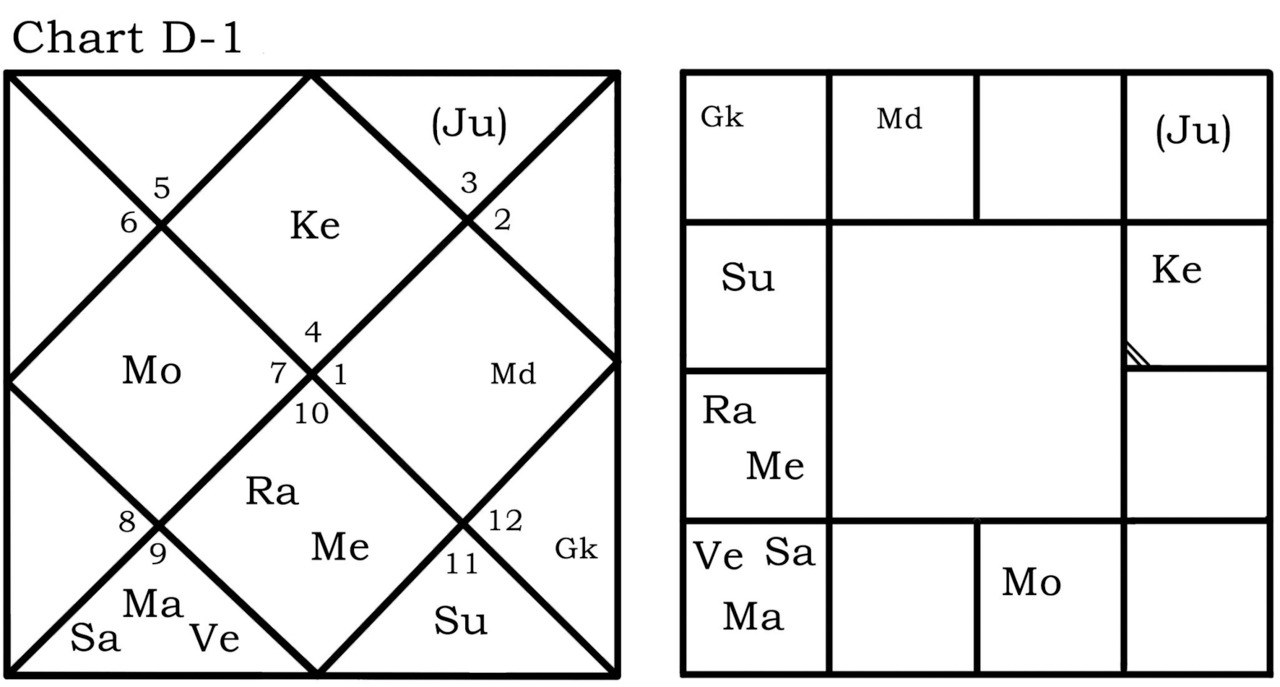

When Saturn entered Scorpio, the woman became a mother.
However, she was diagnosed with breast cancer just a year after giving birth.
Later, she faced a second episode of cancer when Saturn was in Sagittarius, transiting through her Atma Karaka Venus.
Case Study 10: Atrophic Gastritis
One more astrological chart in which Sade Sati led to health problems.
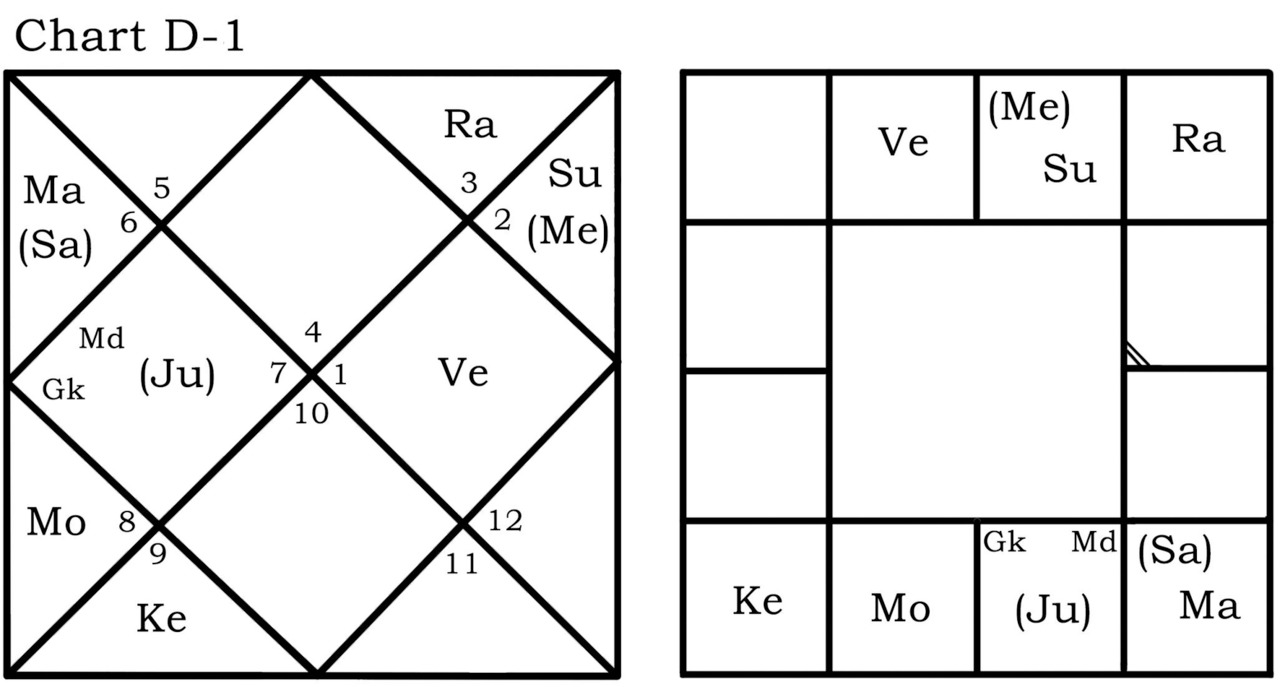

While Saturn transited through Sagittarius, the individual was diagnosed with atrophic gastritis, which caused significant distress.
The treatment lasted about a year, but once Saturn exited the 6th house, the man’s health returned to normal.
Viparita Raja Yoga
I have often heard people express that Viparita Raja Yoga is highly favorable.
Sources describe it like this: "Viparita Raja Yoga is formed by the 6th, 8th, and 12th rulers when they are placed in the Dusthanas, exchange signs, or they form conjunctions. A person with such a yoga will gain property, health, and longevity; they will experience career success, be skilled, earn good money, and leave a positive impression, achieving fame.
When the rulers of these challenging houses share the same sign, aspect each other, or are placed in each other’s houses while lacking any other connections or aspects, this creates stable growth in an individual’s life, leading to good fortune and solid social status. The motto of this yoga is: 'To rise, you must first fall.'"
In my opinion, the positive results of these combinations are often exaggerated.
Let us turn to the birth chart of Joe Biden, the 46th President of the United States.
Case Study 11: Joe Biden. Aneurysm
In this instance, the lords of the 6th and 8th houses are joined together in the 12th house. This is a classic example of Viparita Raja Yoga.
As you know, I analyze the events that occur during the Dasha and Antardasha of the planets before making any judgments about whether they are beneficial or detrimental.
During the Moon-Mars period, Biden tragically lost his wife and daughter in a car accident, and both of his sons were so severely injured that caring for them became his top priority. This period did not lead to any significant rise in his status or major victories.
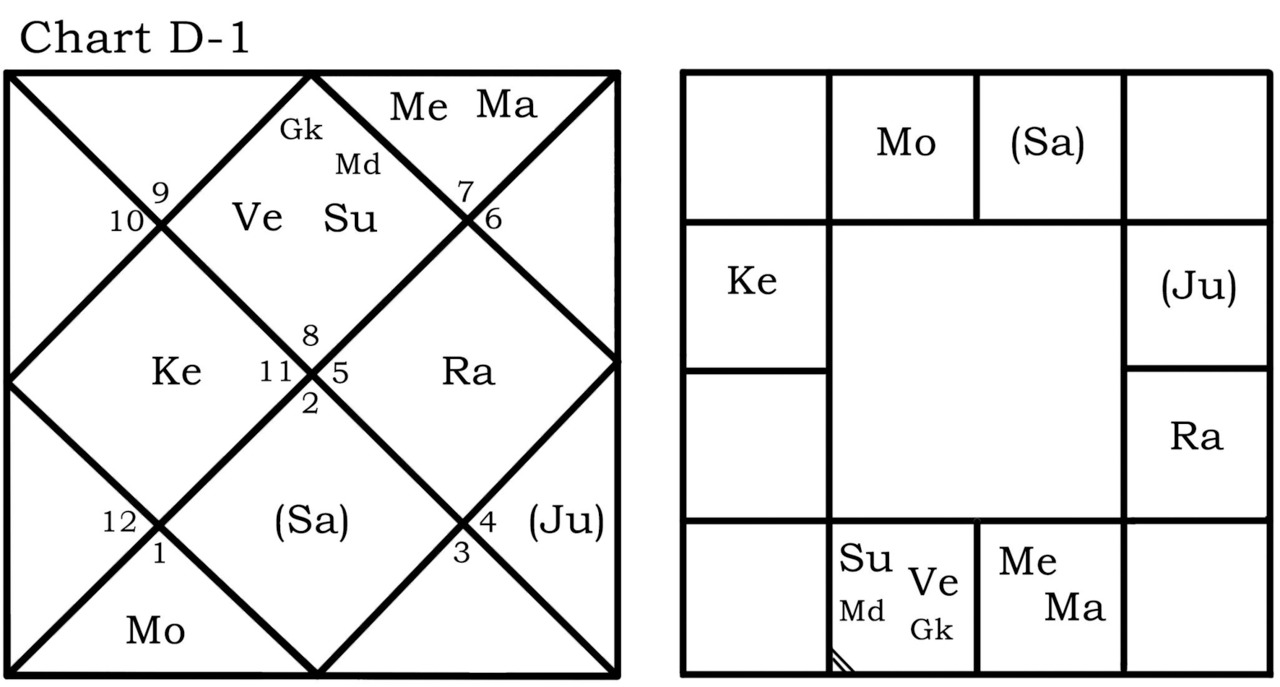

In the following Moon-Rahu period, Joe Biden became a senator. However, this was not due to Viparita Raja Yoga, but rather because of Rahu’s favorable placement in this natal chart, sitting exalted in the Magha Nakshatra within the 10th house of his career.
It appears that Viparita Raja Yoga was not in a hurry to reward Biden with its blessings.
You might think justice would come to light during the Mars-Mercury period, but Biden’s biography shows no significant changes during that year.
Shortly after, though, the Mars-Moon period brought new challenges: an aneurysm that required urgent surgery, putting him in critical condition and resulting in a seven-month career break as he fought to recover.
Other factors also played a key role in defining his success periods. In August 2008, Barack Obama selected Joe Biden for the prestigious position of vice president.
This stroke of luck occurred during the Jupiter-Jupiter period, when Jupiter in Rasi was exalted, ruling the 5th and 2nd houses while positioned in the 9th house of fortune and the support of influential figures.
Viparita Raja Yogas can bring health issues and other setbacks, depending on which house rulers are conjoined or involved in mutual exchange.
It is particularly intriguing when the rulers of the 6th and 8th houses exchange signs. This often leads to legal troubles during the periods of the planets involved in the yoga, as well as significant complications from even minor ailments. Despite this, many astrologers still proclaim the prosperity and positivity associated with Viparita Raja Yoga.
Sometimes, it is better to warn a person about potential negative events and give them a chance to prepare rather than pretending to be all-knowing. A carriage can turn into a pumpkin at the appointed hour, and you might appear kindhearted, but ultimately, you will not be seen as a professional astrologer.
Divisional Chart D-6
D-6 chart (Shashtamsa) represents a sign divided into six parts. This Varga reveals information about diseases, treatments, periods of illness, and even death.
It is essential to recognize that the houses in the Shashtamsa chart correspond to various parts of the Cosmic Man’s body. Therefore, afflictions to specific houses or zodiac signs may indicate a predisposition to certain diseases.
To understand which house governs which body part, let us check the following table:
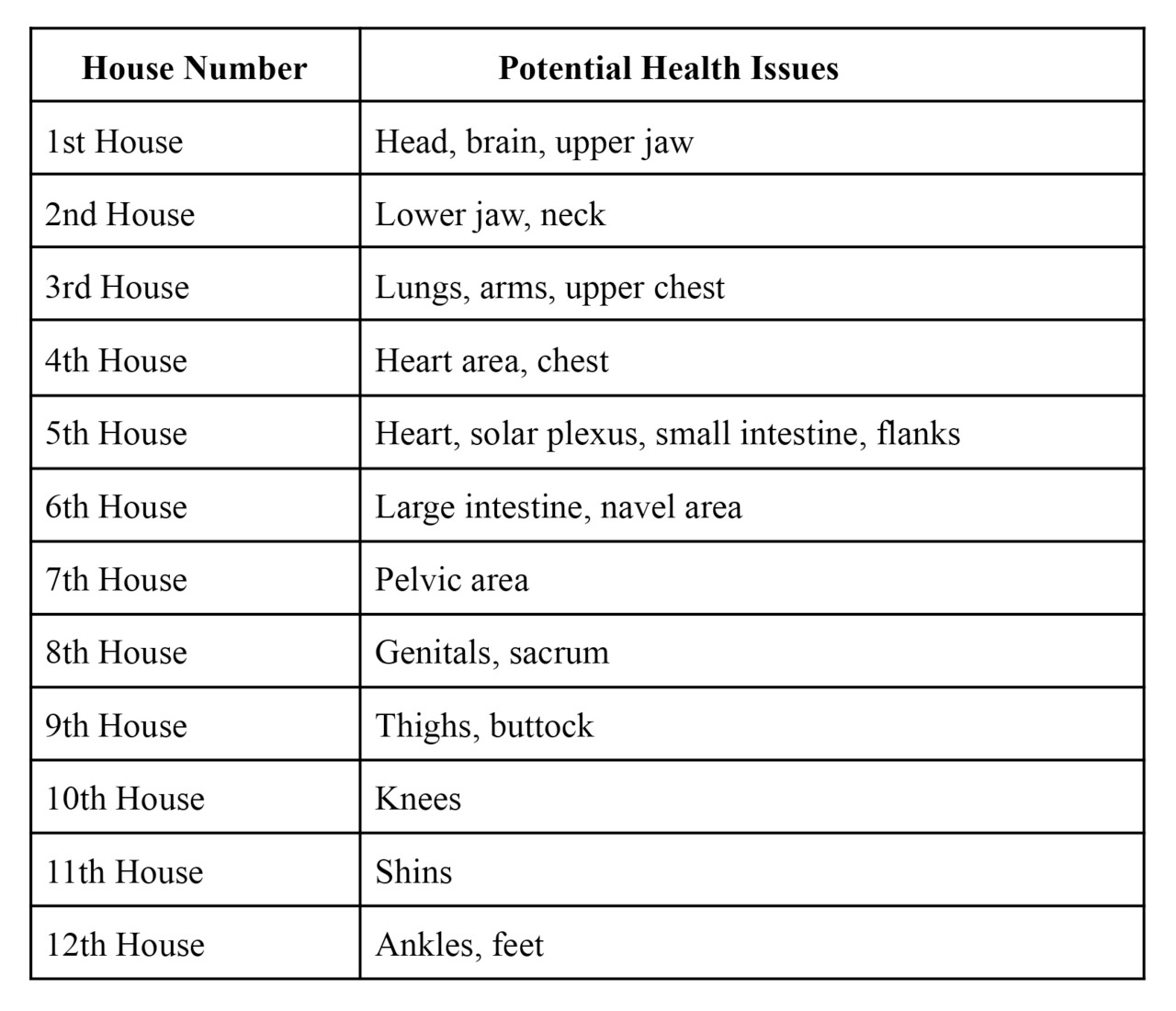
Here are some guidelines I follow when interpreting the D-6 chart:
— The rulers of the 6th, 8th, and 12th houses are very important for determining the timing of illness and death.
— It is beneficial when the rulers of the Dusthana houses are not placed in the 1st house and do not influence the D-6 Lagnesha.
— It is favorable when the Dusthana rulers are located in the 3rd and 11th houses.
— It is disadvantageous if the 6th, 8th, and 12th rulers are overly strong or too weak.
— Planets in the 1st house can also trigger periods of ailments.
The 12th house of the D-6 chart draws my special attention as an astrologer because it reveals the approach to disease treatment and its effectiveness.
It is important to understand which planet influences the 12th house. The stronger its influence, the more significant it becomes in our interpretations.
My hierarchy for assessing the importance of planets, from most significant to least, usually proves accurate:
— a planet located in the 12th house;
— the ruler of the 12th house;
— a planet conjoined with the 12th ruler;
— a planet aspecting the 12th house or its ruler.
If there are afflicted planets in the 12th house or the 12th ruler is weak, then treatments are likely to be ineffective. In such cases, an individual must focus on disease prevention throughout their life to avoid complications.
Those who have a solid 12th house ruler involved in Raja Yoga, Maha Purusha Yoga, or other auspicious combinations are fortunate. In these cases, even serious illnesses may be treated successfully, leading to full recovery. These individuals are often blessed with favorable doctors and circumstances regarding their healing.
If the 12th house ruler is retrograde, or if a retrograde planet is positioned in the house, treatments may need to be repeated.
Now let us examine how different planets placed in the 12th house can influence the nature and methods of treatment:
Mars: when the 12th house is connected with Mars, treatments will likely be surgical, involving invasive procedures.
Rahu and Ketu: when Rahu and Ketu are placed in the 12th house, they may signify treatments involving toxic substances or potent medicines, resembling a kind of poisoning of the individual.
This placement may also lead to the need for opioid medications, treatment with alcohol-based tinctures, and other harmful compounds.
A person with such a placement often requires complex diagnostic methods.
Mercury: if Mercury is positioned in the 12th house, it signifies a careful and responsible approach to treatment, highlighting attentiveness (especially when Mercury is in Virgo) and suggesting that treatments can produce swift results, thanks to Mercury’s nature as one of the fastest planets.
However, if Mercury is afflicted due to combustion, being in a debilitated sign, or other factors, treatment results may be opposite to expectations or only temporary.
In general, Mercury can yield unstable treatment outcomes unless it is in its own signs or auspicious yogas. Such individuals often respond well to standard chemical treatments for their illnesses.
The Moon: in the 12th house of D-6, the Moon suggests that a person’s condition improves when they calm their nerves and mind.
Due to fate, these individuals may be prescribed treatments that involve water and medicinal liquids such as syrups, solutions, or drops.
This combination can make the natal chart owner exceptionally sensitive to mood variations. Psychological comfort becomes key to their successful treatment.
Jupiter: when the 12th house is influenced by a strong Jupiter, prayers, pilgrimages, and other spiritual practices serve as effective remedies for the person.
Additionally, such treatments often affect hormonal balance and liver function.
Venus: positioned in the 12th house, Venus indicates a favorable treatment outcome, provided it is not afflicted or retrograde.
Relief from illness should come relatively quickly, and the treatment process should be comfortable and gentle.
Saturn: in the 12th house, Saturn points toward treatments involving fasting, cold conditions, or a more austere approach.
Treatment may be prolonged and exhausting only if Saturn is not positioned in the signs of Libra or Capricorn.
The Sun: when the Sun is placed in or influences the 12th house, treatment may involve strengthening the immune system and restoring its normal function.
A severely afflicted 12th house or its ruler tends to bring difficulties. The next example will illustrate this.
Case Study 12: Incurable Brain Disease
Below is a case of a person suffering from a rare brain disease called amyotrophic lateral sclerosis. He is unable to move or even breathe.
His treatment consists solely of life support in an intensive care unit, but his condition shows no signs of improvement.
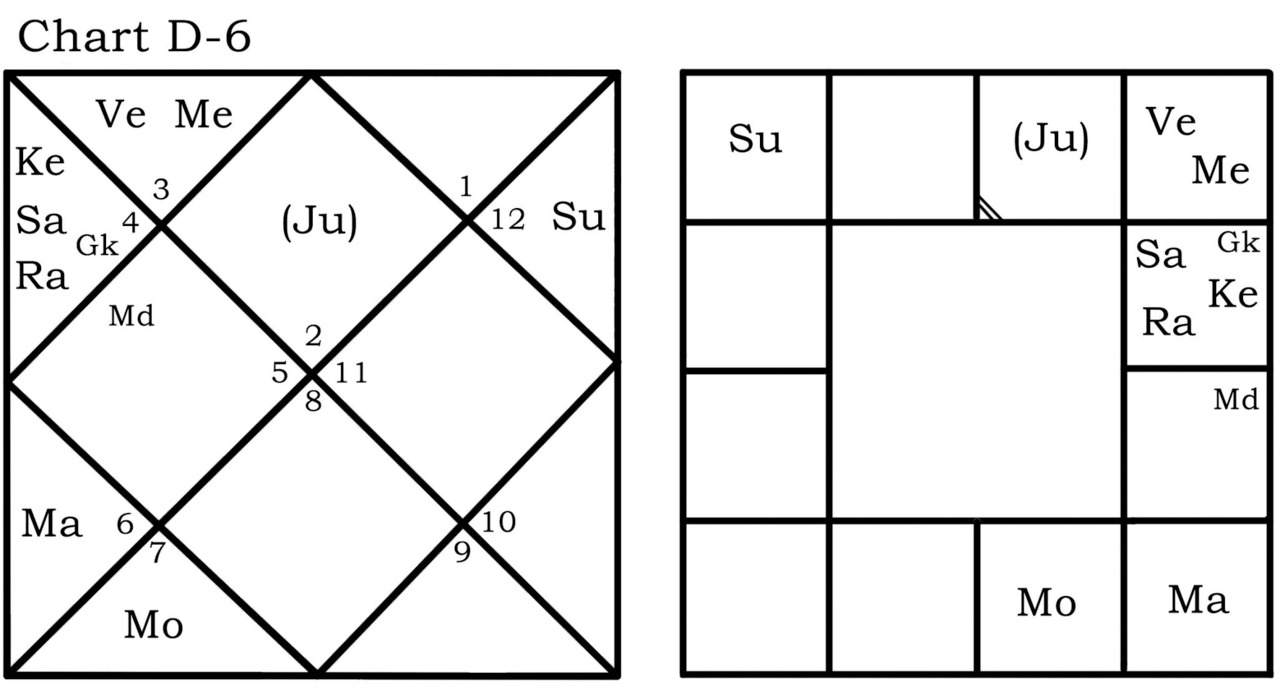
The 12th house ruler, Mars, is aspected by two malefics — the Sun and Saturn.
Saturn also aspects the 12th house from the 3rd house.
The speed of recovery and the onset of treatment effects often depend significantly on the movement speed of the planets positioned in the 12th house.
To better understand how planetary speed relates to their influence, below is a list of the planets arranged according to the distance they cover within a single day.
The fastest-moving planets appear at the top, while the slowest are at the bottom. In our assessments, we rely on the average recovery time for the majority of patients with a specific condition, rather than on our personal impressions.
Here is the list that shows the planets according to their speed and the distance they cover within a single day:
— the Moon — 13°;
— Mercury: 1.2° to 1.5°;
— Venus: 1°;
— the Sun: 1°;
— Mars: 0.5°;
— Jupiter: 0.07°;
— Saturn: 0.03°.
For example, if the treatment of an illness takes one year, a person with exalted Mercury in the 12th house might experience noticeable improvements in just 3—4 months. If Saturn is involved, it may extend healing time to 1.5 to 3 years.
Death in Natal Chart
Death marks the end and complete cessation of the biological and physiological processes that sustain our bodies.
Death can be analyzed using both Chara Dasha and Vimshottari Dasha. Below, we will examine each approach in detail.
Death in Chara Dasha
The Chara Dasha periods serve as the primary tool for determining when a person may pass away.
It is essential to understand the following general principles of Chara Dasha period analysis:
— The start of a period or sub-period shifts the Lagna to the sign of the current period. For an Aries Lagna, entering the Leo period shifts the Lagna to the 5th house for the entire duration of Leo. I recommend redrawing the birth chart for Leo while keeping all the planets in their original zodiac signs.
— The sub-period also shifts the temporary Lagna.
— When we examine the Chara Dasha period, we identify the general trends and promises of the period. When we analyze the sub-period, the details and exact timing of events become clear.
— It is crucial to determine what kind of karaka a given planet has become. For example, a benefic Venus can become a Gnati Karaka and be associated with the 6th house, indicating illnesses, accidents, and other misfortunes.
During Chara Dasha analysis, we actively consider the sign aspects of the planets relative on different houses in the natal chart, based on Jaimini’s principles:
— all movable signs (1, 4, 7, 10) aspect all fixed signs (2, 5, 8, 11), except the neighboring one;
— all fixed signs (2, 5, 8, 11) aspect all movable signs (1, 4, 7, 10), except the neighboring one;
— all dual signs (3, 6, 9, 12) aspect each other without exception.
Karakas are symbolic indicators of certain additional functions that planets perform in the natal chart.
I consistently follow the 7-karaka system and exclude Rahu from the list of planets that can serve as karakas. If your astrological program includes Rahu as a karaka, I recommend adjusting the settings to match mine for greater clarity and consistency while reading this book.
Let us go through the meanings of the karakas:
— Atma Karaka (AK) represents the 1st house and signifies a person’s health and physical well-being.
— Amatya Karaka (AmK) corresponds to the 2nd, 10th, and 11th houses, indicating a person’s finances, profession, and income during specific periods.
— Bhatri Karaka (BK) symbolizes the 3rd and 9th houses, indicating siblings, father figures, friends, and well-wishers.
— Matri Karaka (MK) indicates property, mother’s destiny, and the person’s place of residence. It is associated with the 4th house.
— Putra Karaka (PK) signifies children, creativity, and romantic interests. It has a symbolic connection with the 5th house.
— Gnati Karaka (GK) indicates illnesses, enemies, dangers, and accidents. It is connected with the 6th and 8th houses.
— Dara Karaka (DK) relates to the 7th and 12th houses, indicating a marriage partner and the personal life’s well-being. Its connection to the 12th house can reflect periods of illness and death.
In Chara Dasha, we also look for Raja Yogas, which are formed through combinations such as:
— conjunctions of Venus, the Moon, Jupiter, and Mercury in any combination;
— conjunctions of Atma Karaka (AK), Amatya Karaka (AmK), Putra Karaka (PK), and Dara Karaka (DK) in any combination;
— a mutual aspect of the planets mentioned in the previous two points on the same sign creates a Raja Yoga in that zodiac sign.
The indication of death in Chara Dasha may look like this:
1. The ruler of the 1st house is severely afflicted (like being combusted, positioned in the 8th house, debilitated, in conjunction with Maandi and Gulika, and so on).
2. The ruler of the 8th house is afflicted and/or connected with the 1st house. For example, the ruler of the 1st house can be located in the 8th house from the beginning of the period or vice versa. They may also occupy the same house in any of the 12 houses.
3. The 8th house contains malefics, debilitated planets, Maandi, Gulika, or afflicted planets.
4. A lack of benefic influences on the 8th house is a significant indicator of danger to life, and this principle also applies to the 1st house of the temporary Lagna.
5. Atma Karaka is often located in the Dusthanas from the temporary Lagna.
Planets in the 6th and 8th houses from the temporary Lagna of the Chara Dasha’s Mahadasha will indicate which diseases or events may be dangerous during that period.
Mercury may indicate viral diseases, Venus kidney issues and accidents, while Rahu could suggest infectious diseases, and so on.
The detailed formulas for diseases described below will clarify which ailments are associated with certain planets, so we will not delve further into this topic right now.
Death in Vimshottari Dasha
It is tough to pinpoint death using the Vimshottari Dasha in many natal charts. This is usually the case for individuals with chronic illnesses or those whose lives are expected to end after a prolonged struggle with health issues.
There are also people prone to various injuries, illnesses, and struggles throughout their lives. In all these instances, there will be several planets that meet our criteria.
Only the combination of Vimshottari Dasha and Chara Dasha provides reliable insights. It is also recommended to review the astrological charts of close relatives to confirm the loss of a loved one during the indicated period.
Be cautious with the birth charts of spouses. If you are predicting the lifespan of someone who could have another 20-30-40 years ahead of them, there is a chance that their partner may not be around for that long.
Instead, focus on the natal charts of children and siblings. However, even a parent’s chart is not always reliable, as in many cases the parent passes away earlier, except in tragic instances where the child dies young.
Keep in mind that your goal is to identify the planet that signifies death. Death stands apart from other events; it will undeniably occur at some point.
An astrologer often searches for occurrences that may never happen, but death is certainly present in the natal chart. Simply knowing this will give you greater strength and motivation when determining the right Vimshottari Dasha.
So, what indicates that the Dasha of the planet bringing the end of life has begun:
1. The Dasha ruling planet is connected with the 8th house in the divisional charts D-1, D-9, D-3, and D-12.
This list is prioritized by importance; sometimes D-12 may not indicate such a connection.
By ‘connection’, I mean the planet’s placement in the 8th house, an aspect from the 8th house lord, a conjunction with the 8th house lord, or an aspect from the Dasha lord to the 8th house lord.
2. The planet might hold a special status in the D-6 chart: it could sit in the 6th and 8th houses, rule those houses, and have a connection with the 1st lord or the Lagna.
3. The planet can be placed in the nakshatra of the 8th house lord or of another planet located in the 8th house of the D-1 chart.
Other signs of planetary affliction also matter. I have tried to identify what sets death apart from illness or other unfortunate events within this context.
But also take into account combustion, the planet’s presence in the nakshatra of a malefic, Mrityu Bhaga, Sarpa Drekkana, planetary wars, and similar factors.
Classification of Death
There are different types of death:
— natural or physiological death: occurs in old age when metabolic processes slow down, causing a decline in organ function;
— pathological death: happens at a young or middle age, often due to diseases or other unfavorable circumstances (for example, chronic or incurable illnesses);
— violent death: includes deaths resulting from accidents, murder, or other unforeseen events.
We can also categorize death based on its suddenness:
— sudden or unexpected death: occurs when a person dies despite appearing to be in good health (aneurysms, strokes, or heart attacks);
— predictable death: results from chronic serious illnesses, where a person’s condition progressively worsens and their quality of life diminishes over time — the person fades away gradually.
When analyzing a natal chart to determine the end of life, the first step is to identify the type of death. It is only afterwards, if the illness can be specified, that one should focus on the specifics.
Do not rush to pinpoint the disease leading to death, as some aspects of the astrological charts can be so complex that complete clarity may be elusive.
Yet, simply identifying the type of death already provides insights into how a person’s fate may unfold and offers potential avenues to shift that fate in a more positive direction.
The primary indicator for distinguishing between these types of death is the sequence of periods in the Vimshottari Dasha and Chara Dasha.
As you might know, the sequence remains constant:
— Ketu;
— Venus;
— the Sun;
— the Moon;
— Mars;
— Rahu;
— Jupiter;
— Saturn;
— Mercury.
However, this sequence starts at different points in each birth chart. Life paths also vary due to the unique planetary positions. For one person, Jupiter may signify death; for another, excellent health — it all depends on its placement in the chart.
Ultimately, the Moon’s placement plays a crucial role, reshuffling all pieces in our lives at birth. After all, it is the Moon’s position in a specific nakshatra that determines which planet begins the 120-year Vimshottari Dasha cycle.
Let us examine each type of death closely, one by one.
Natural Death
When a person dies from natural processes associated with aging and bodily deterioration, certain signs can be observed in their astrological chart:
— Health is generally good. The Moon is positioned favorably, the Kendras contain benefic planets (Jupiter, Venus, or Mercury), and the rulers of the 6th, 8th, and 12th houses do not influence the Lagna and the Lagnesha.
— Saturn does not aspect the 6th house and its ruler in the D-1, D-6, and D-9 charts.
— There will be few or no retrograde planets in the birth chart.
— The sequence of Mahadashas will be such that each subsequent period is not significantly worse than the previous one.
— Most Dashas tend to be equally good for health; death may feel hidden within the periods, not appearing overly active or vibrant — it might seem absent from the natal chart.
Natural death can also result from a disease that easily takes hold in an organism weakened by age. However, this manner of dying appears to be the softest and simplest compared to others. Death during sleep is particularly peaceful, but we will discuss this type separately.
Pathological Death
Pathological death refers to dying at a young or middle age due to disease, malnutrition, or other causes.
It is important to understand that such death is not typical and signals serious afflictions in the health-related areas of the astrological chart.
Signs of pathological death may include:
— an afflicted 1st house and Lagnesha;
— combustion of planets related to the 1st house;
— a planetary war involving the lords of the 1st and 8th houses;
— the presence of Viparita Raja Yoga;
— the nakshatra Satabhisha, occupied by planets;
— afflicted rulers of the 12th, 6th, and 8th houses;
— aspects from the 6th, 8th, and 12th rulers to the 1st house or Lagnesha;
— retrograde planets as rulers of the 6th, 8th, and 12th houses.
The sequence of Mahadashas and Antardashas displays negative health effects. It is difficult to determine which Dasha will be decisive — they are all tricky and indicate a situation that is ’on the edge’.
Typically, the last 2—3 Mahadashas are equally detrimental to health in such cases. Among the Antardashas, one can identify the worst one, the period pointing directly toward death.
The very period of death, as indicated by Chara Dasha or Vimshottari Dasha, usually follows this most challenging phase and may seem to indicate some improvement.
It appears better at first glance, but this improvement can be misleading. Often, a person may die from illness 2—4 months after the worst Antardasha concludes.
This scenario represents the most complex and challenging cases.
Case Study 13: Cerebral Palsy
In this example, we look at a child who died at the age of 12 after living with severe cerebral palsy his entire life.
The boy managed to survive a short period during the Saturn Dasha and a part of the Mercury Dasha.
Saturn, ruling the 8th house of death, afflicts the Moon and the 5th house of neurological health. Rahu’s aspect makes Saturn even more destructive.
Did the individual benefit from Saturn’s exaltation? He remained alive, and that is already significant in such a situation.
The 1st house ruler, Mercury, being in the 8th house and afflicted by Mars, is sufficient to indicate the likelihood of death in this instance.
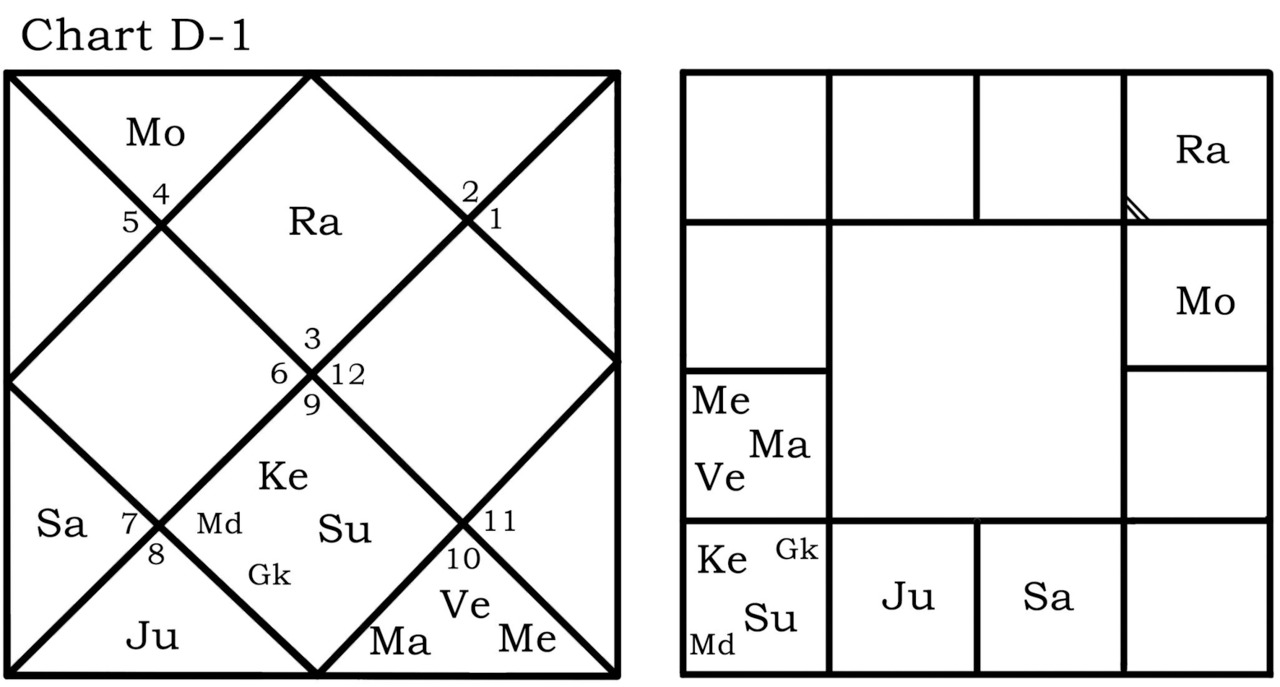

In this example, the following observations can be made:
— the Rahu-Ketu axis afflicts the 1st house;
— the lord of the 1st house, Mercury, is located in the 8th house;
— Mercury is positioned together with Mars, the lord of the 6th house;
— the ruler of the 6th house is in the 8th house, indicating health complications due to illnesses;
— Atma Karaka (AK) Mars is in the 8th house alongside Gnati Karaka (GK);
— the ruler of the 12th house, Venus, is in conjunction with the Lagnesha in the 8th house of crises;
— the Moon is afflicted by the aspects of Mars and Saturn.
Case Study 14: Lung Cancer
Let us examine the chart of a man who died of lung sarcoma.
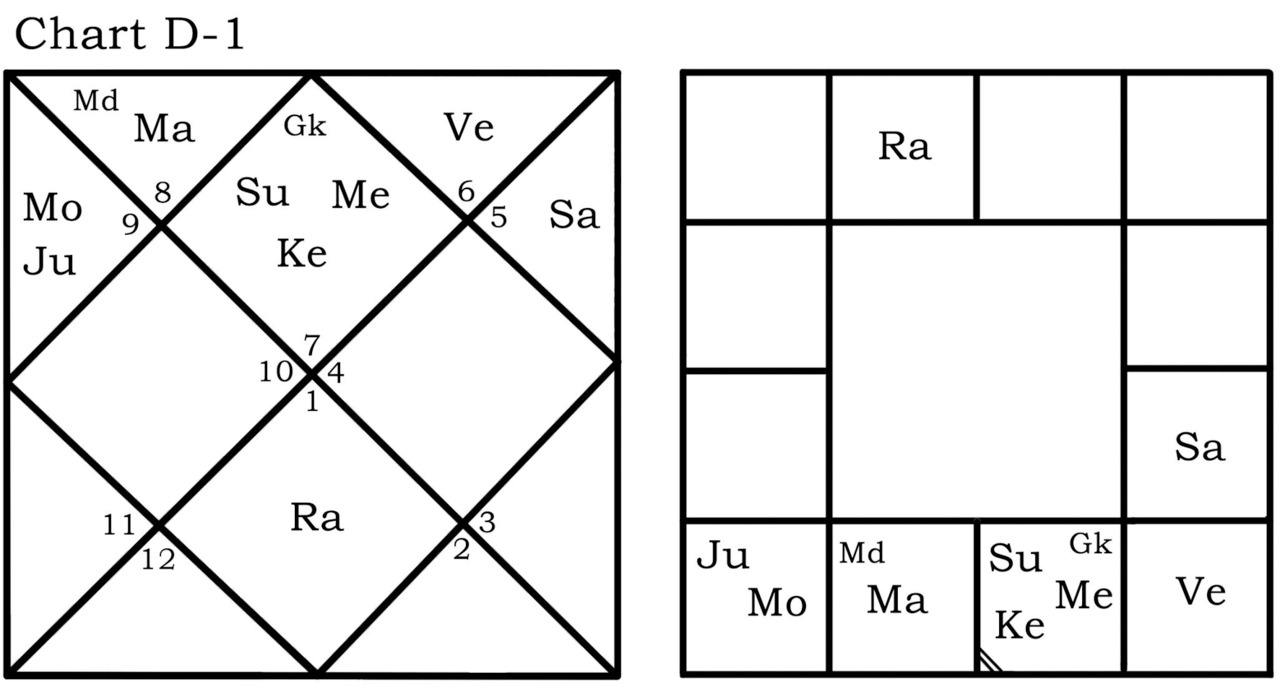

In this example, there is only one benefic in the Kendras, which is the ruler of the 12th house of diseases and treatments.
A debilitated planet in the 1st house harms health.
The Jupiter Dasha, lord of the house of diseases, marked the onset of an oncological illness.
The man died during the Antardasha of Saturn. Saturn aspects the 1st house, thus causing harm to health. It is also aspected by Rahu and the lord of the 6th house, and is placed in the nakshatra of the malefic Ketu.
Violent Death
Violent death is relatively easy to identify, exhibiting distinct and recognizable features.
Case Study 15: Princess Diana. Crash
In this example, we analyze the natal chart of Princess Diana, who died in a car accident on August 31, 1997, while still in a period of vitality and apparent good health.
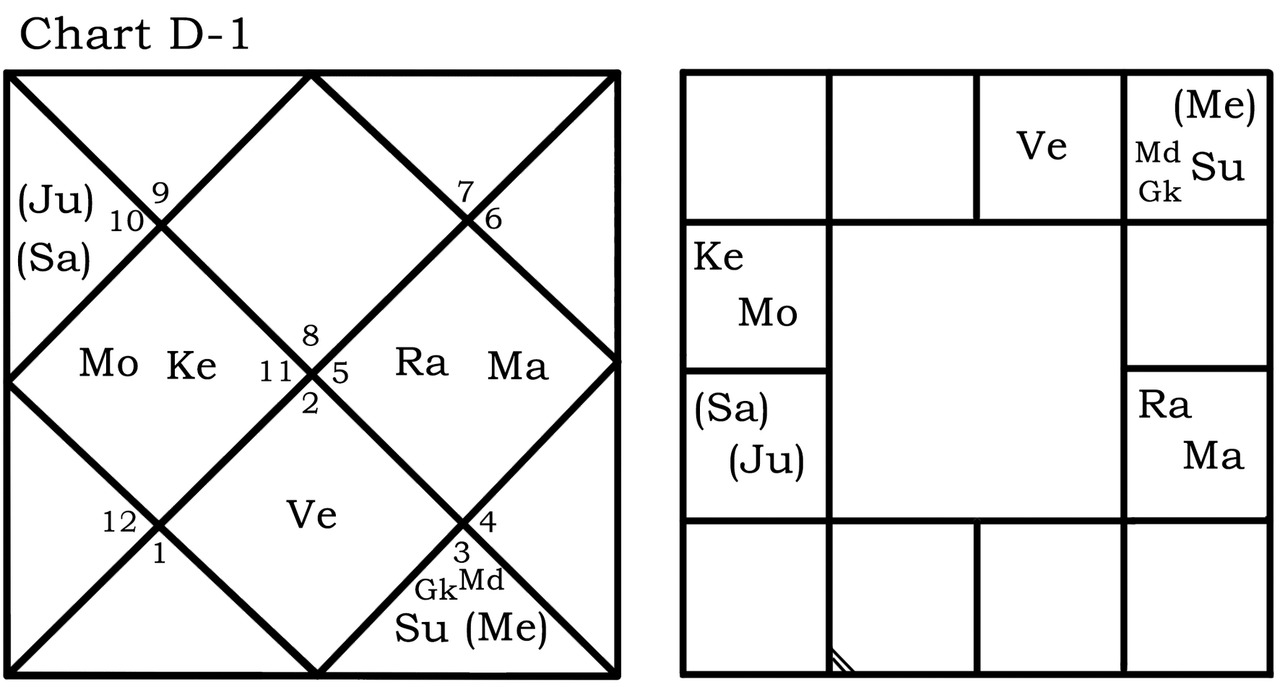

Here, we observe classic signs of a violent death:
1. The conjunction of Mars and Rahu, with one having a connection to the 6th house of misfortune. This combination frequently appears in cases of individuals who have succumbed to violent or sudden deaths. The aspect between Rahu and Mars also contributes to this interpretation.
2. The ruler of the 1st house is positioned in the 8th house. Typically, a conjunction between the lords of the 1st and 8th houses suggests a violent or unnatural death. As well as when the ruler of the 8th house is placed in the 1st house.
3. The Dasha of an afflicted planet (retrograde debilitated Jupiter in conjunction with Mars). This is a common marker of violent death. It could involve the ruler of the 8th, 12th, or 6th houses, or Lagnesha Dasha if it connects with the 8th house.
4. An abundance of malefics in the Kendras suggests a lack of protection from benefics.
Princess Diana’s death occurred during the Jupiter-Rahu period.
Jupiter is debilitated and in a harsh conjunction with Saturn in the 3rd house of roads.
Rahu afflicts Mars, the ruler of the 1st house.
According to Chara Dasha, this was during the Gemini-Cancer period.
Gemini: the 8th house from Gemini is significantly afflicted. Although the ruler of the temporary Lagna is in its own sign, it sits alongside Maandi and Gulika. Additionally, this marks the period of the 8th house from the Lagna.
Cancer: the 1st ruler is in the 8th house along with Ketu, while the Atma Karaka Sun is placed in the 12th house. The ruler of the 8th house is retrograde and conjoined with Jupiter.
Sudden Death
You might disagree, but sudden death can often be a blessing for a person. As the old Soviet film says: "You blink — and you are already in heaven."
However, natal charts associated with such deaths tend to look dire and often contain signs of a violent end. They do have some identifiable features.
Case Study 16: Adolf Hitler. Suicide
Let us examine Adolf Hitler’s astro chart. He took his own life on April 30, 1945, during the Rahu-Venus period.
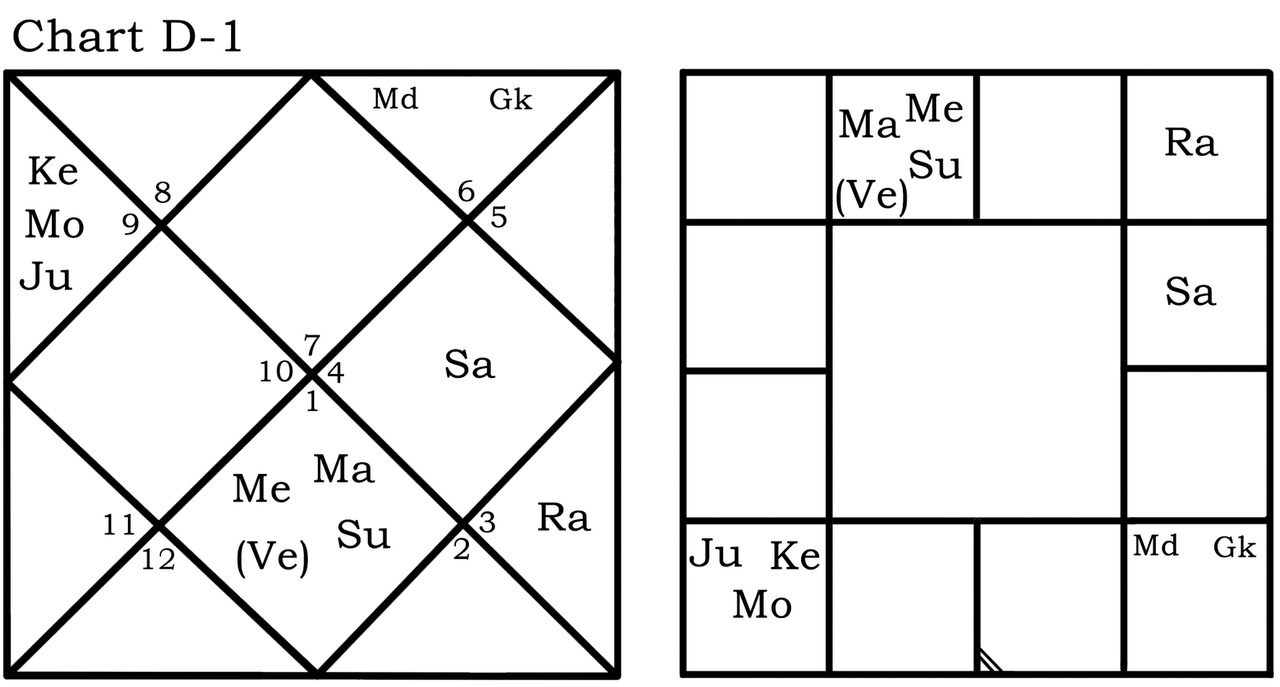

Let us analyze the signs of sudden and violent death evident in this example.
1. The periods leading up to Venus Antardasha are relatively favorable. Saturn, Mercury, and Ketu do not indicate an increase in suffering due to health issues nor do they imply health damage.
2. The Venus Antardasha is unfavorable, as it is conjoined with Mars and the Sun, aspected by Saturn, retrograde and in conjunction with the 12th house ruler. Venus, the ruler of both the 1st and 8th houses, carries the weight of all survival functions.
3. A sharp decline in the favorability of the death period compared to the previous one is a major indicator of sudden death.
In such charts, we often observe only one or two unfavorable periods followed by more favorable ones.
So, why did death occur during the Rahu Dasha? Rahu is positioned in the Punarvasu Nakshatra under the rulership of Jupiter, which is the ruler of the 6th house of misfortunes.
Rahu has an aspect on the 1st house, and this is a harmful aspect.
Predictable Death
A foreseeable death is a prolonged process of illness during which a person becomes aware that they may soon pass away. Undoubtedly, it is a tremendous source of stress, clearly visible in the natal chart.
Sometimes health issues worsen insidiously, as seen in conditions like atherosclerosis, where blood vessels gradually narrow over time until a heart attack occurs.
While the deterioration of health can be noticeable in the astrological chart, individuals may not fully grasp the seriousness of their situation, opting to ignore symptoms or suppress them with medications without proper oversight.
In most cases, the person becomes aware that recovery is impossible and that they are facing death.
In the D-6 chart, in cases of death from prolonged illnesses, Saturn often aspects the ruler of the 8th house or the 8th house itself. This formula can be echoed in the main chart.
Case Study 17: Fyodor Dostoevsky
Let us take the example of Fyodor Dostoevsky. He suffered from epilepsy and tuberculosis for many years and passed away in the winter of 1881 during the Saturn-Rahu period.
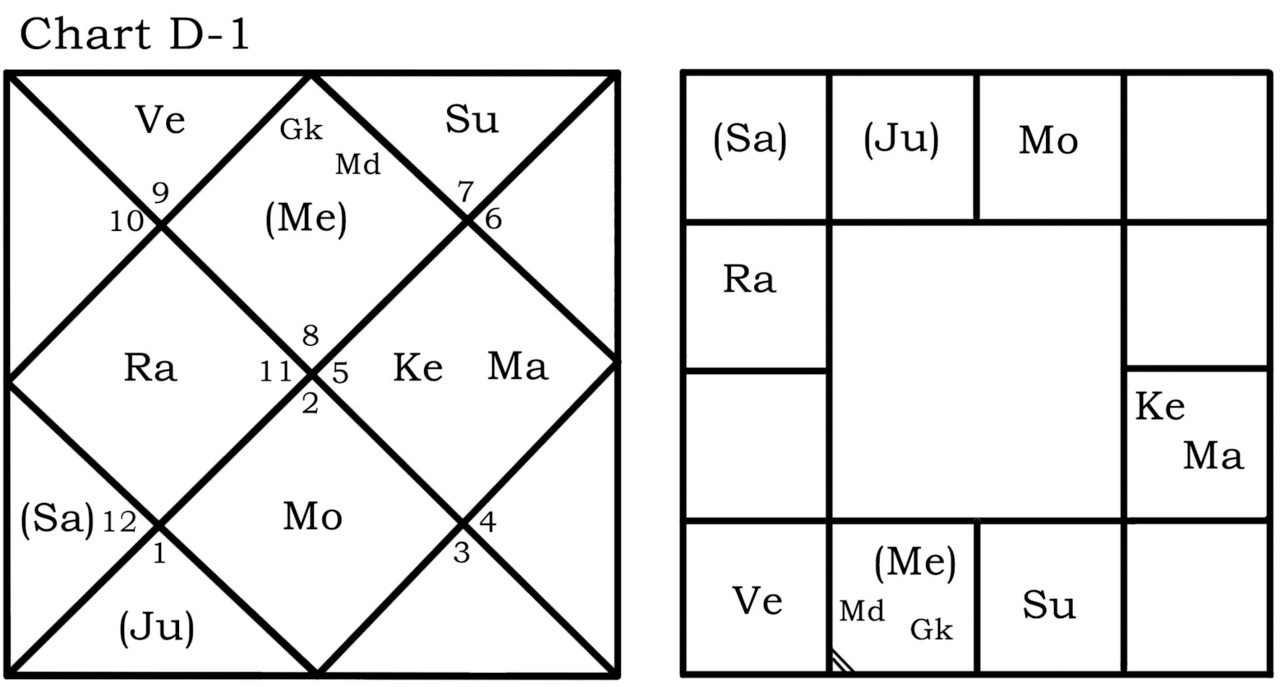

Saturn signifies chronic diseases. In Dostoevsky’s natal chart, it is retrograde and aspects the Moon, the indicator of the psyche, as well as Venus, the ruler of the 12th house related to isolation, treatments, and medicine.
The position of the Moon in the Navamsa does not improve, and the aspect of Rahu in its fall from the 12th house afflicts Jupiter and Mars.
The ruler of the 5th house in D-9 is also afflicted, and the 5th house is affected by the aspects of Saturn and retrograde Mercury, which is the ruler of the 6th house. Mercury itself is afflicted by Mars.
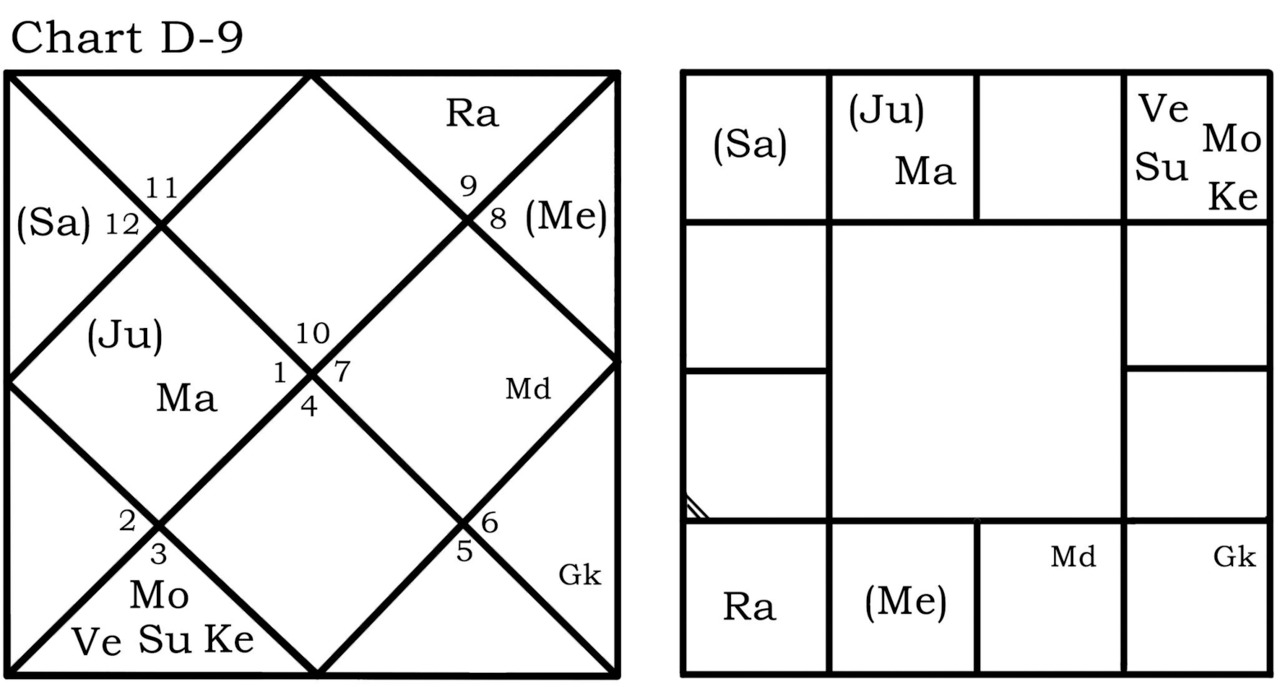
In the D-6 chart, Saturn is positioned in the 2nd house and aspects the 8th house. Saturn’s Dasha began in 1865, worsening the writer’s health over the years.
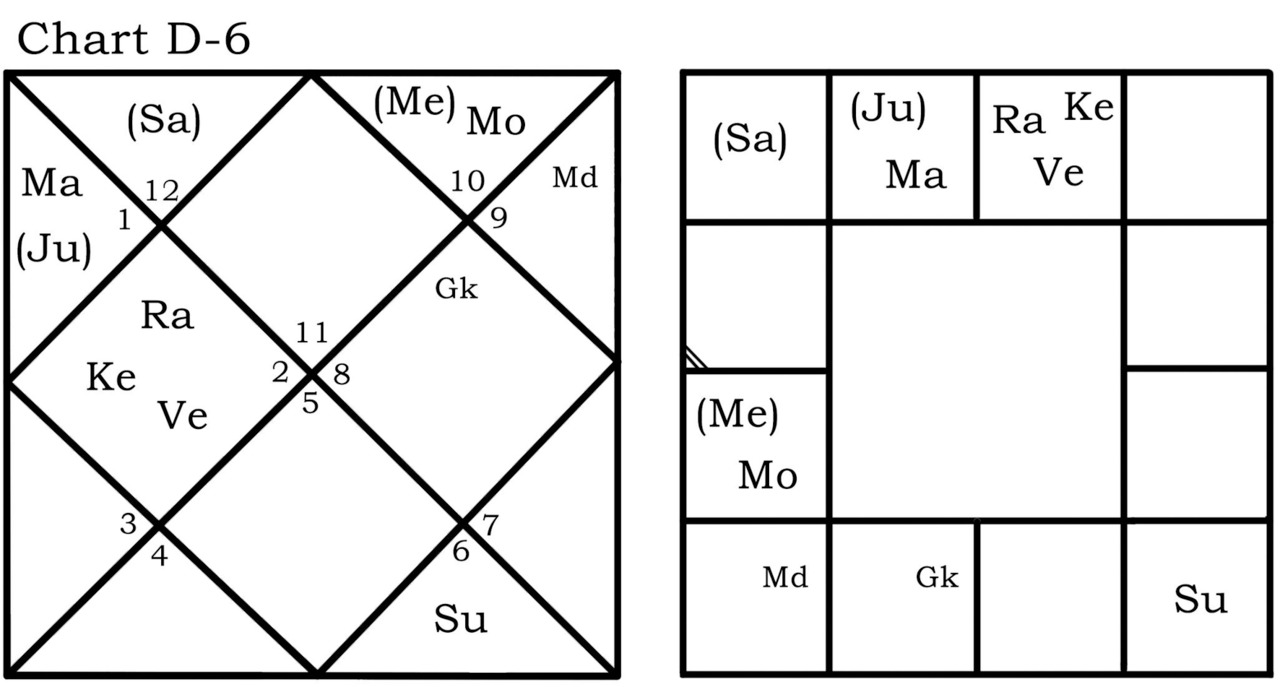
In addition, in the D-6 chart, Rahu is located in the Satabhisha Nakshatra, which is associated with incurable diseases.
Looking back further into the writer’s youth, we see a long period of Jupiter Dasha, which is retrograde and located in the 6th house of disease.
The sequence of Dashas highlights complications from illnesses and a gradual decline in the individual’s condition. Each Dasha provides substantial reasons to be concerned about health.
We will revisit this case to understand the cause of death and not just its nature.
Chronic Diseases in a Birth Chart
It is crucial to determine whether a person will live without major health concerns or if they will endure discomfort due to chronic illnesses over the years.
A death caused by a chronic condition typically follows a specific sequence of Antardasha within the Vimshottari Dasha system. Typically, each subsequent period has a connection with the Dusthanas, is afflicted by malefics, combusted, or features other afflictions in the D-1 and D-9 charts.
The presence of Saturn in key positions of the chart becomes a significant factor in the development of chronic illnesses.
Potential signs of a chronic illness in the D-1 chart include:
Бесплатный фрагмент закончился.
Купите книгу, чтобы продолжить чтение.
